Santa Fe Mine
QUICK FACTS
OWNERSHIP
100% Lahontan Gold
LOCATION
Mineral County, Walker Lane – Nevada
LAND PACKAGE
26.4 Km2
MINERAL RESOURCE ESTIMATE
1,539,000 Au Eq and 411,000oz Au Eq Inferred. A total of nearly 2,000,000 oz.
2025 WORK PLAN
For 2025 the Company plans continued optimization of the Santa Fe mine plan, resource expansion drilling, and refining the metallurgical flow sheet, in parallel with our permitting activities. Lahontan also plans an initial drill test of our West Santa Fe project targeting new gold and silver resources to augment the existing resources at the Santa Fe Mine.
KEY TAKEAWAY
Work on the asset has outlined shallow, oxidized Au & Ag mineralization as well as deeper high-grade potential. The recently completed PEA demonstrates strong project economics for the resumption of mining at Santa Fe.
REPORT
CORPORATE PRESENTATION
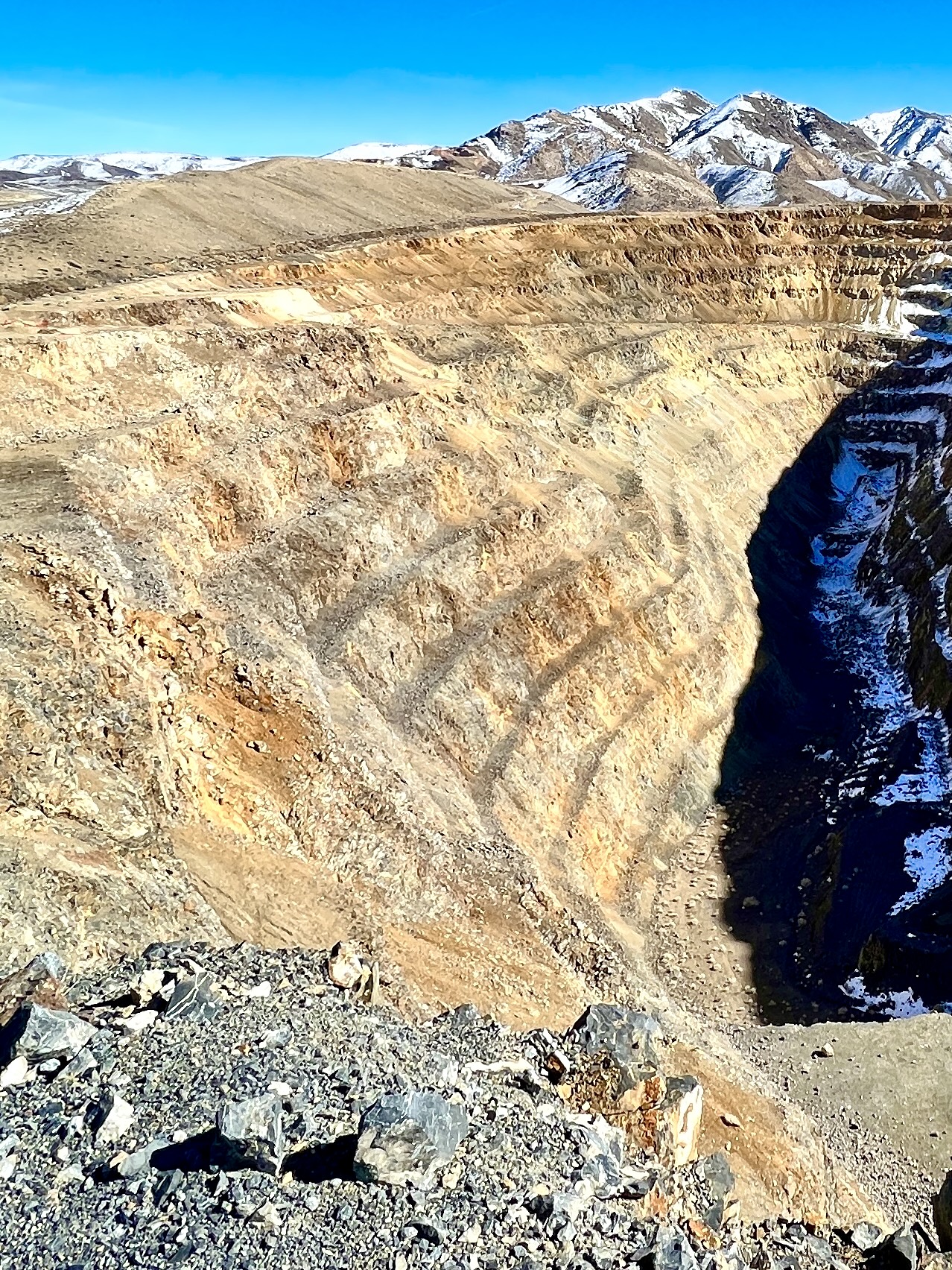
- GEOLOGY
- EXPLORATION TARGETS
- CLAIM OWNERSHIP
- SLAB-CALVADA AREA
- PHASE 1 DRILL RESULTS
- PHASE 2 RESULTS 2022
- PHASE 3 RESULTS 2023
- 2024 DRILLING
- PINNACLE TARGET AREA
• Walker Lane 60-80km wide Physiographic province of northwest Striking faults. Triassic sediments (predominantly carbonates) are intruded by Jurassic to Cretaceous diorite and granite, and overlain by Tertiary volcanic rocks.
• Alteration and gold mineralization controlled by NW, NE and EW structures.
• The Triassic Luning carbonate rocks are often brecciated, decalcified, silicified and sulfidized. Tertiary volcanic rocks are typically clay altered, sulfidized, and locally silicified.
• Generally, Luning Formation carbonate rocks outcrop in the southern half of the property while Tertiary volcanic rocks outcrop in the northern half of the property.
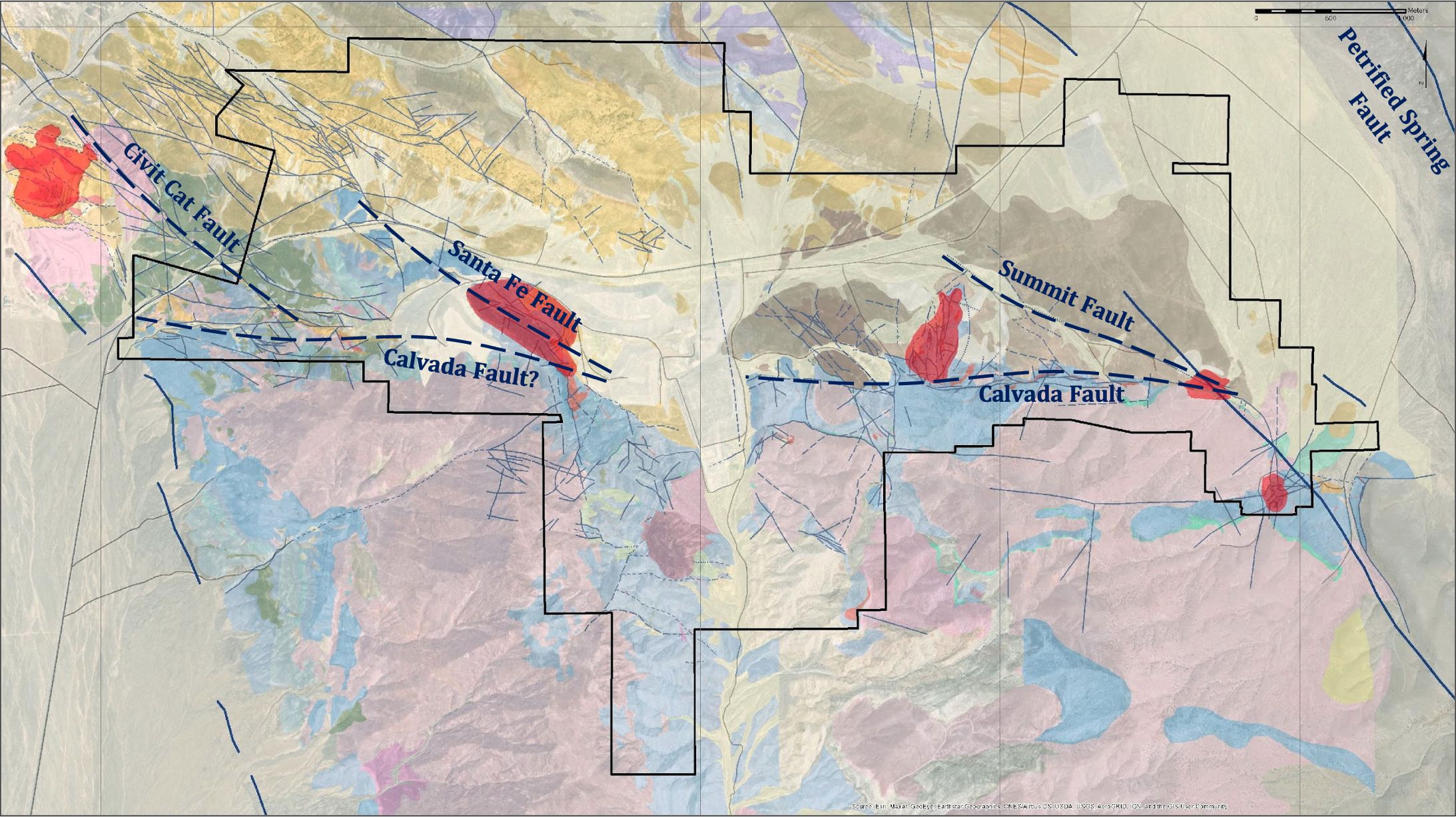
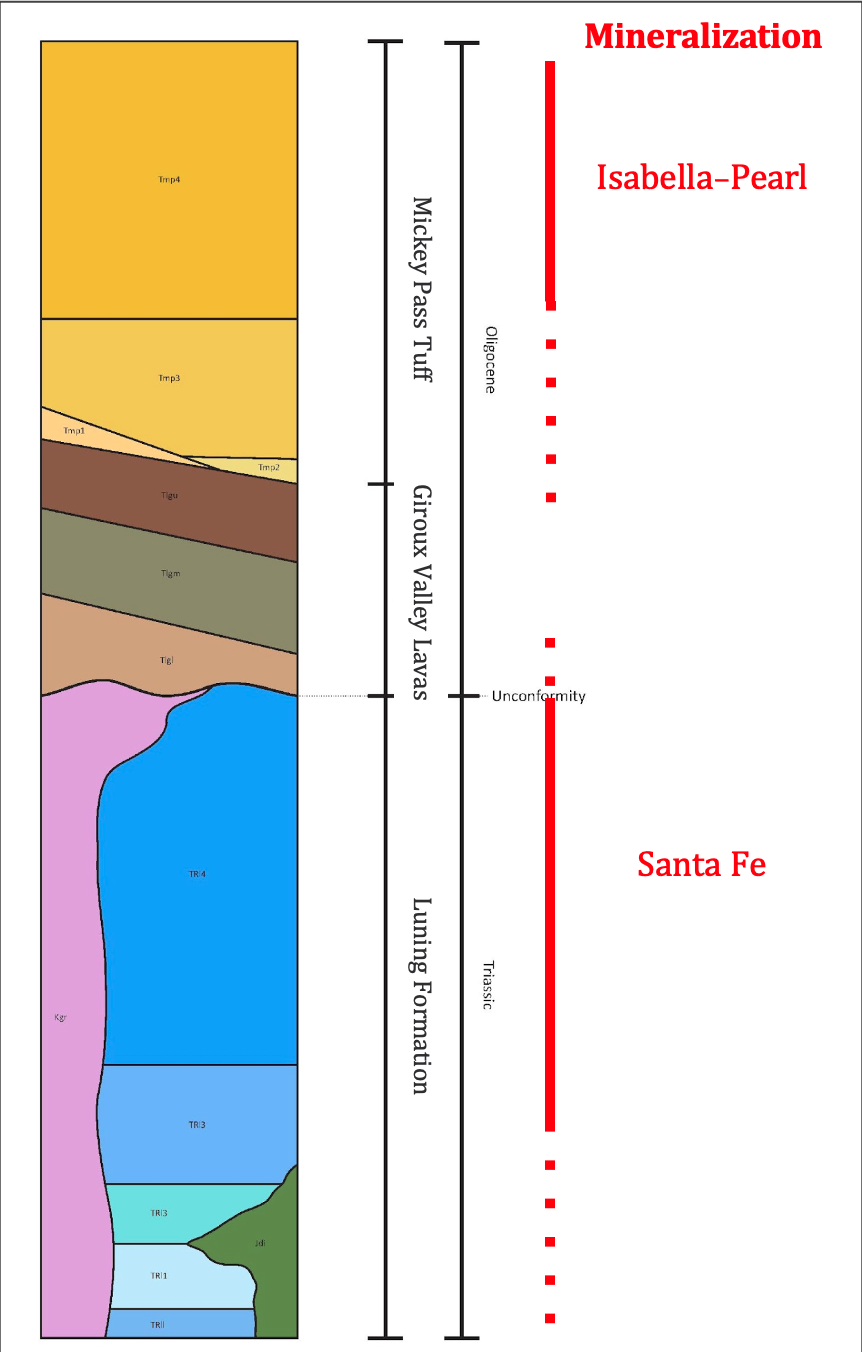
• Productive open pit mines are related to east-west and northwest trending faults. Exploration and development focused on outcropping gold mineralization with little drilling between the pits.
• The Pinnacle target area is underlain by Miocene volcanic rocks and is geologically similar to the Isabelle-Pearl Deposit (P&P Reserves: 2.3M tonnes grading 3.05 gpt Au, 18 gpt Ag (220,100 oz Au, 1.2M oz Ag).
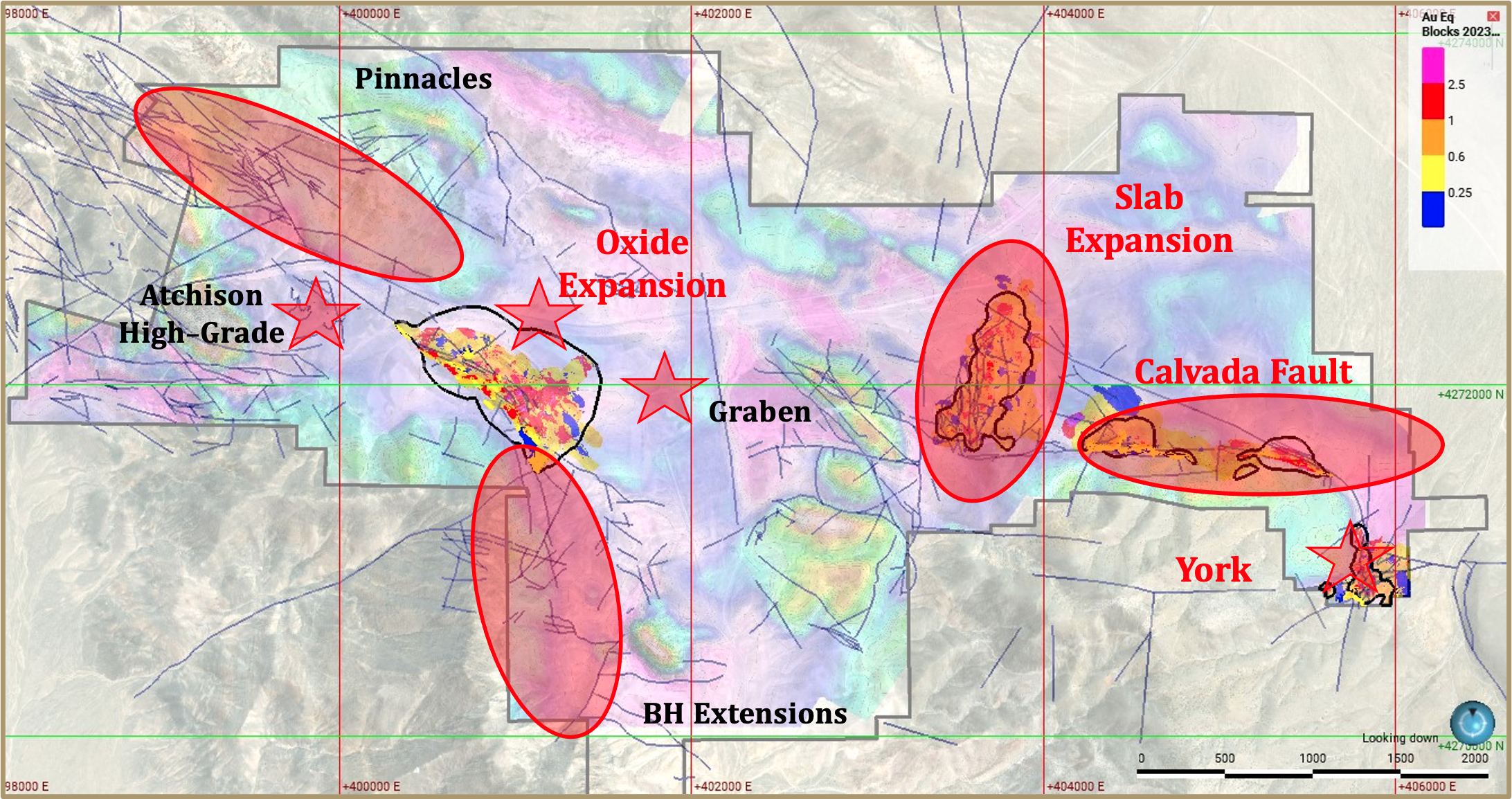
26.4 km² Land Package:
• 291 unpatented lode mining claims
• 67 unpatented mill site clams
• 24 patented lode mining claims.
• Except for 45 optioned unpatented lode mining claims, all mining claims are 100% owned by Lahontan
Past Production:
• Open pit mines processed by heap leach. Reported recoveries were approximately 70% for gold and approximately 30% for silver. Strip ratio for Santa Fe Pit was 1.7, for Slab Pit < 1.
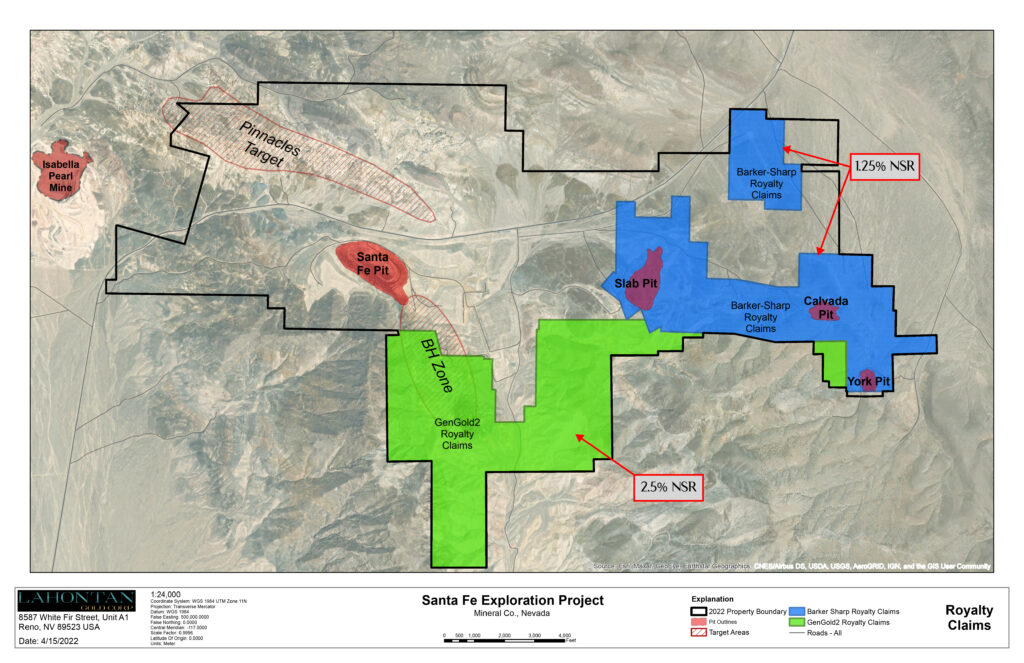
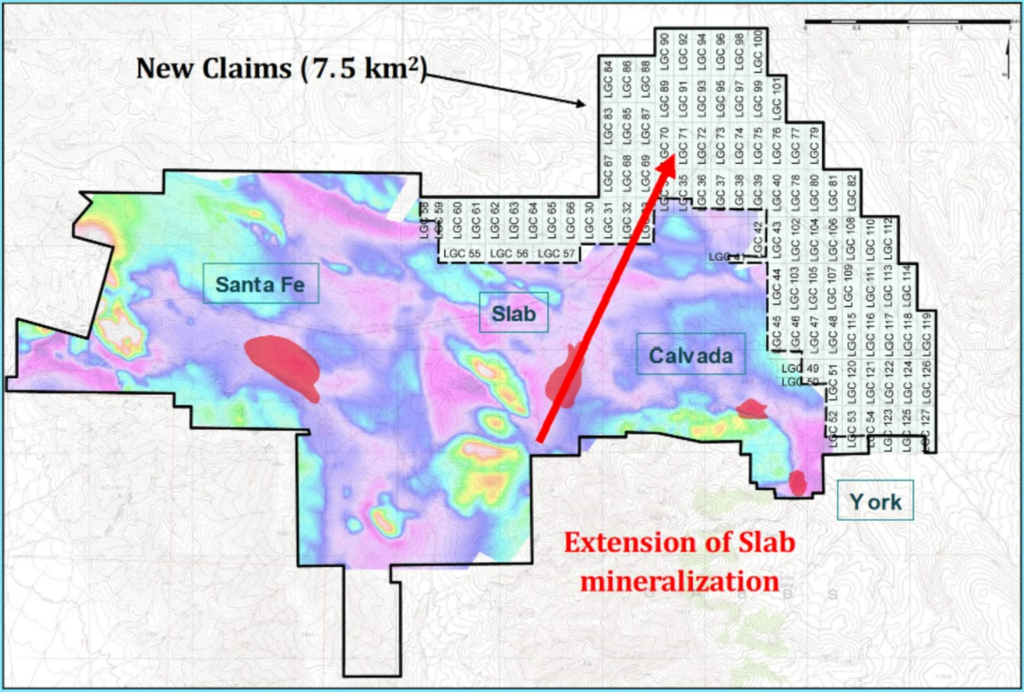
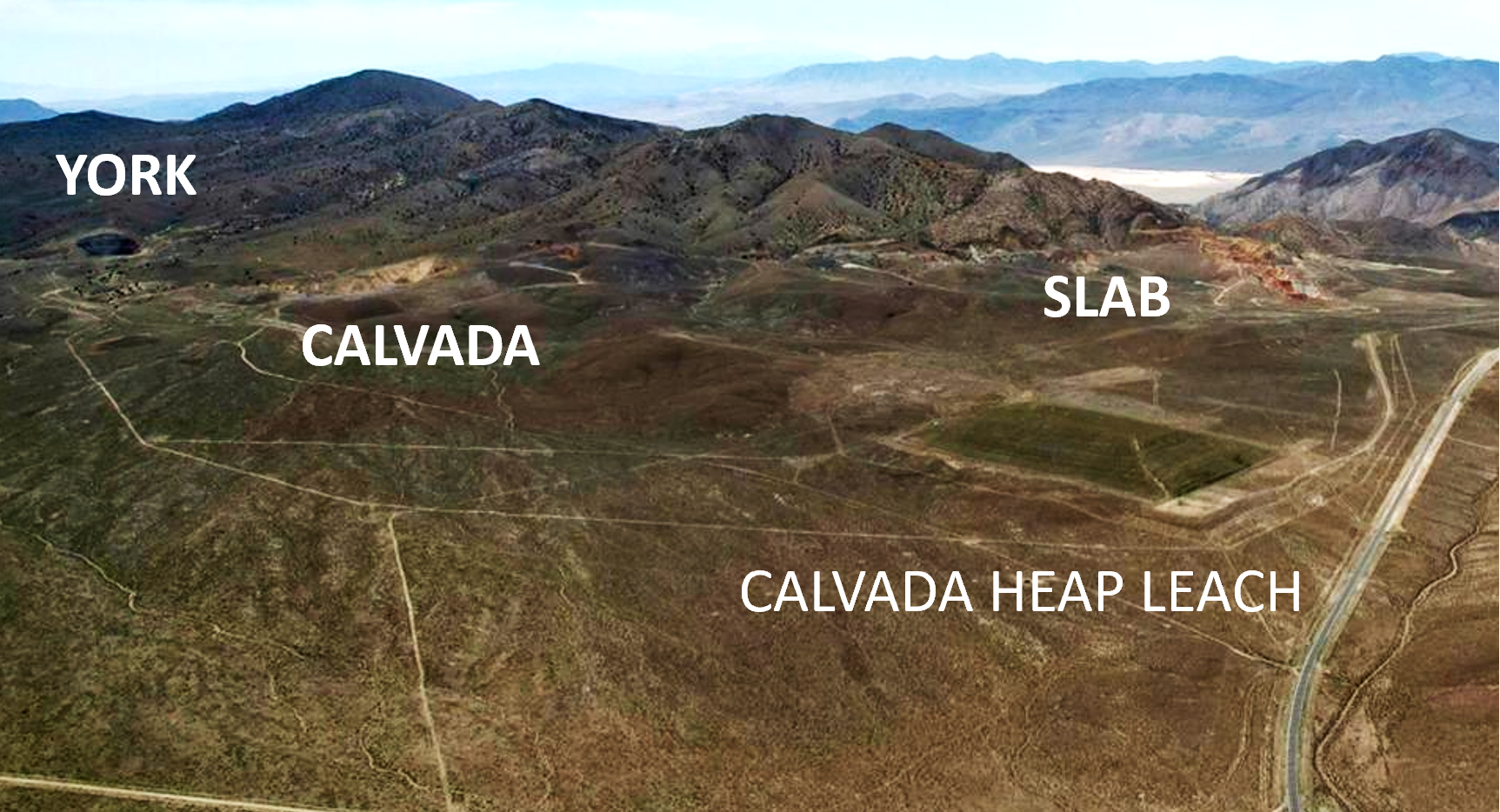
East Santa Fe District with the three past producing open pits (Slab, Calvada, and York) with the Calvada heap leach facility in the foreground. Mining took place in 1992 and 1993 with residual leaching into 1994.
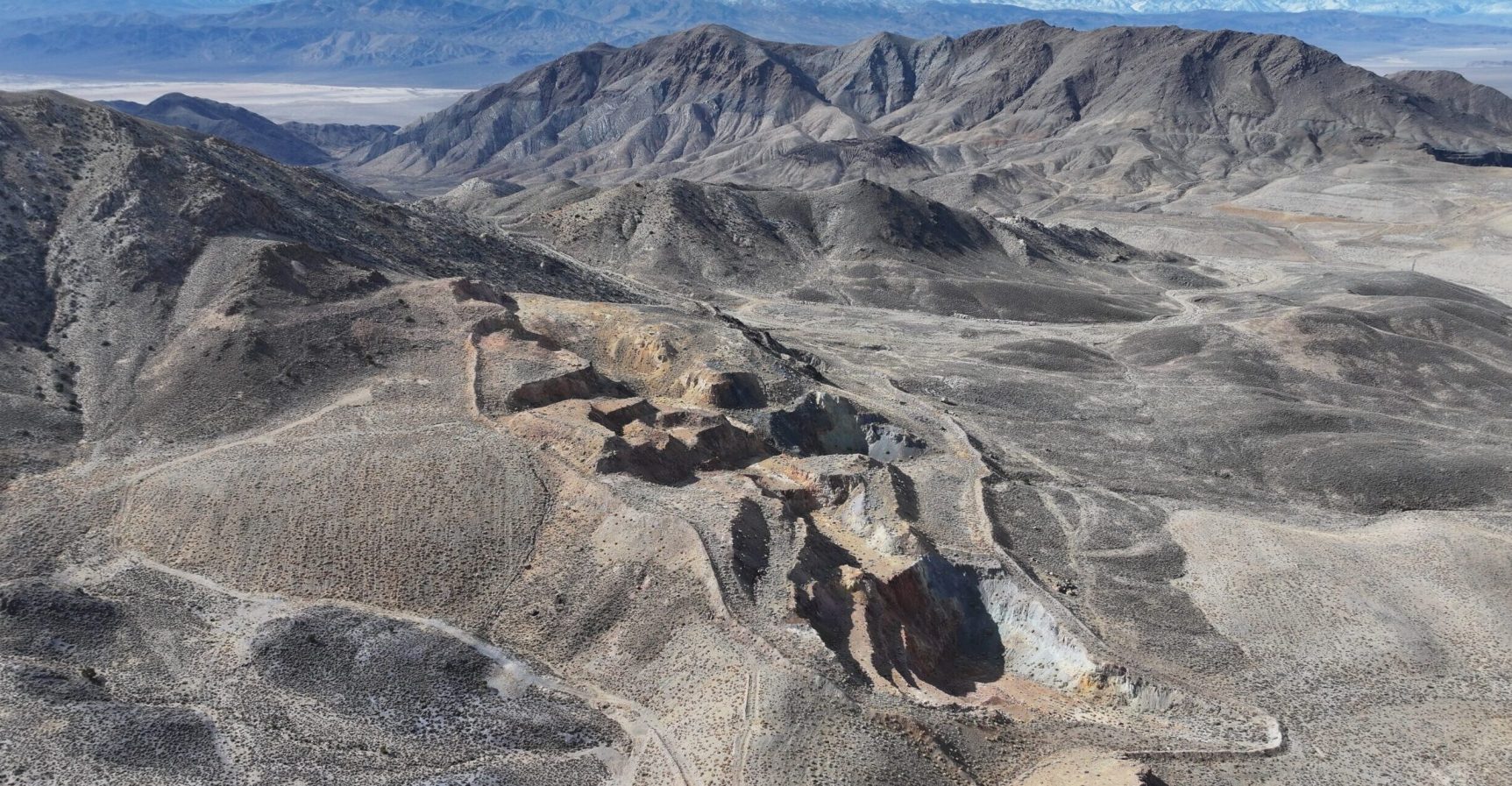
View of the Slab pit looking South. Average grade of crushed ore in the Slab-Calvada area was excellent: 1.18 g/t Au and 5.8 g/t Ag. Mineralization crops out at the surface making Slab-Calvada an important resource for potentially restarting mining operations.
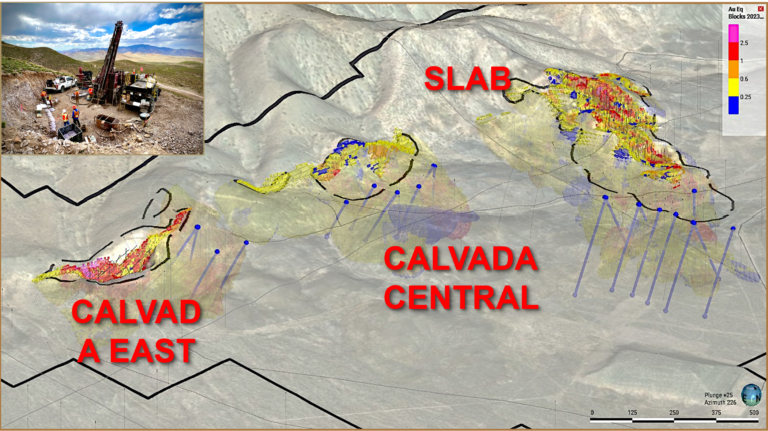
Exploration drilling has focused expanding known resources in and around the Slab and Calvada pits and linking the two areas in what is termed Calvada Central.
- Summary
- Phase 1A
- Phase 1B
- Phase 1C
- Phase 1D
- Phase 1E
- Phase 1F
- Phase 1G
In total, Lahontan drilled 9,410 metres in its 2021 Phase One drilling campaign resulting in the discovery of two new high grade “feeder” zones, Bonanza and Big Horn, the expansion of the BH high-grade zone, and impressive volumes of good grade shallow oxide and transition gold and silver mineralization at both the main Santa Fe pit target area and at the Slab target area (see cross sections of the Santa Fe Pit below).
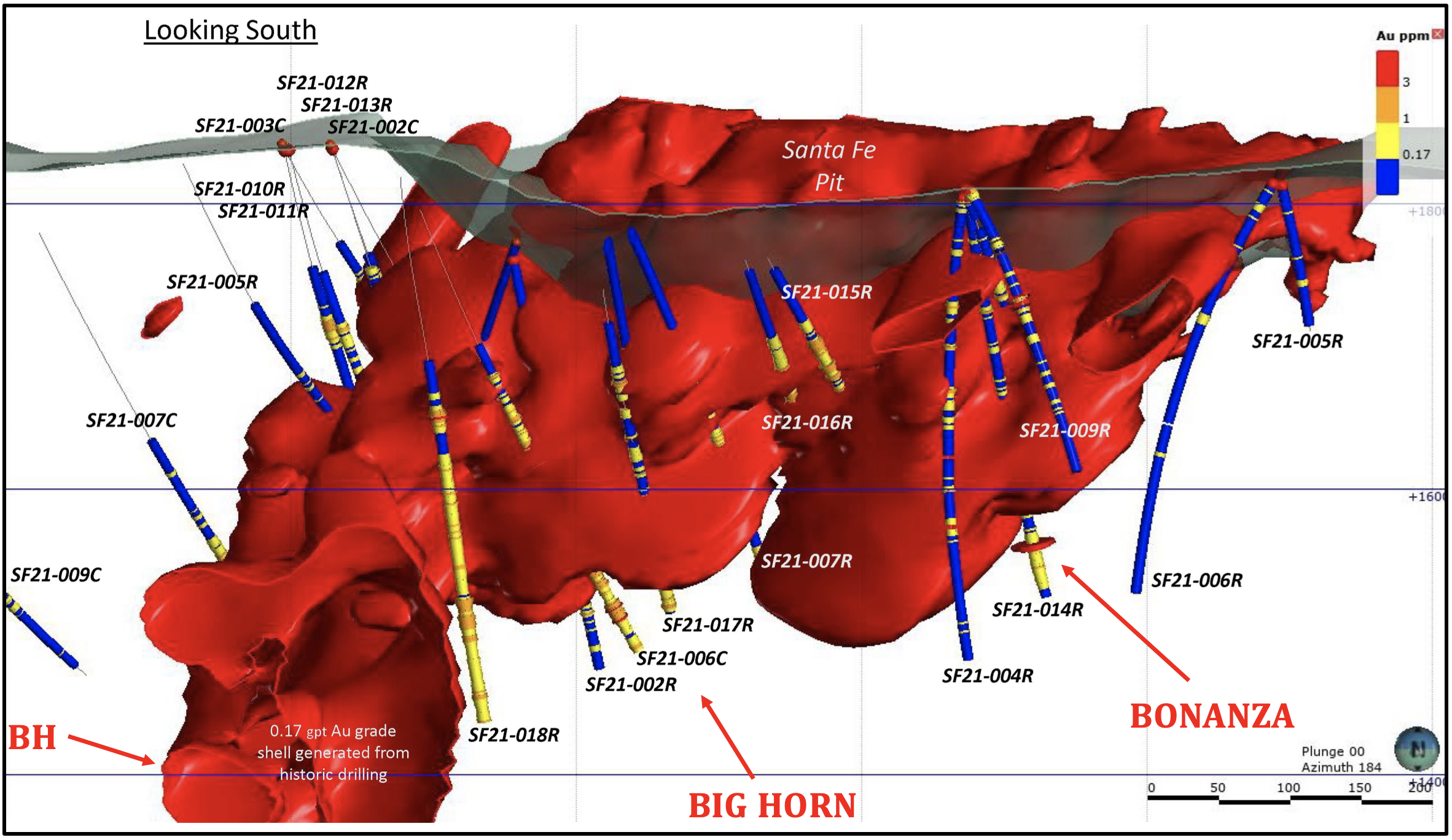
Cross section through all 2021 Lahontan drill holes in the Santa Fe pit area. The 2021 drilling campaign was extremely successful in expanding the volume of gold and silver mineralization in areas adjacent to 0.17 gpt grade shell defined by previous drilling (shown in red above). Note how Lahontan drilling has opened-up potential new gold and silver resources, especially in the newly discovered high-grade zones and deeper portions of the BH zone.
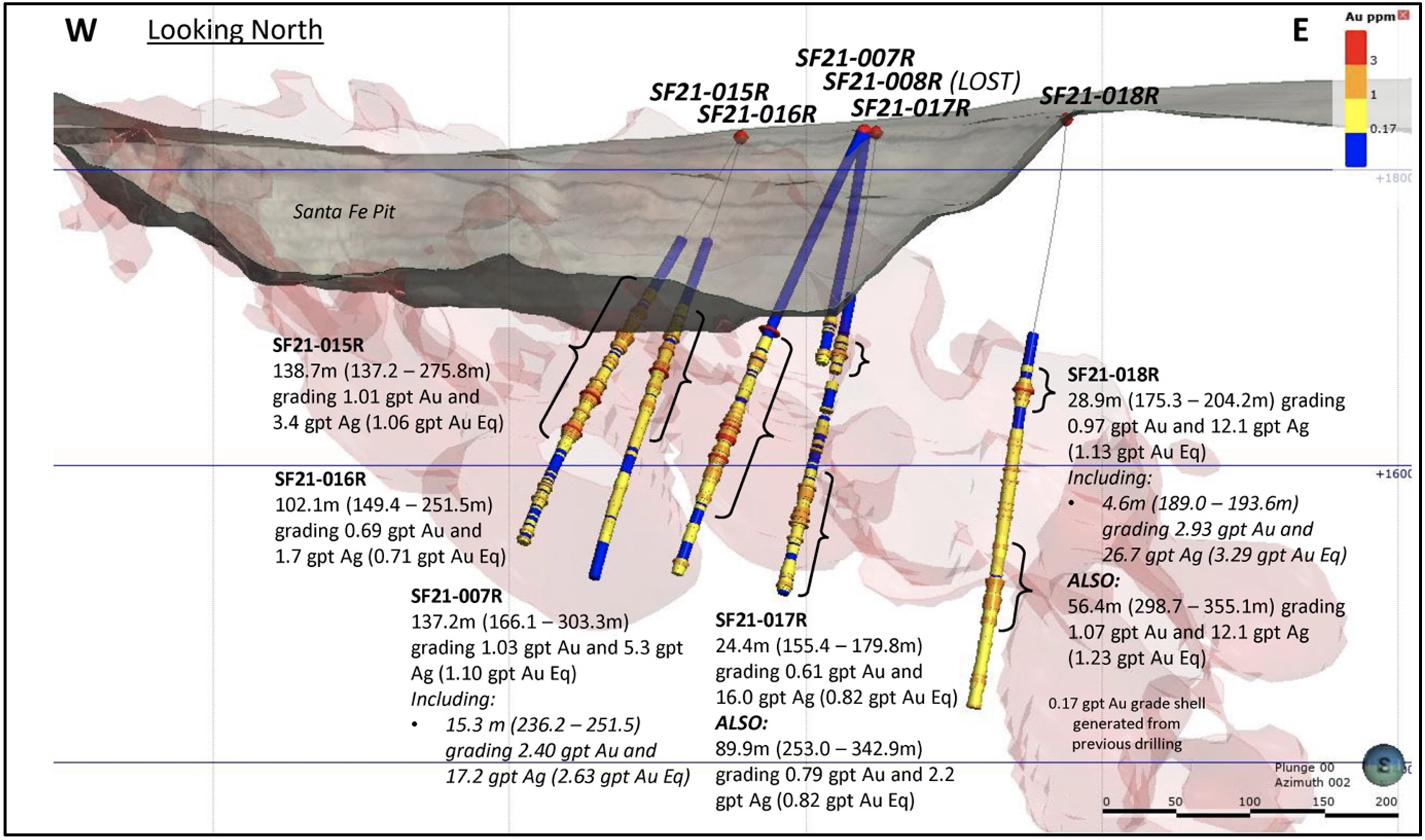
Central Santa Fe Pit Drill Holes: As noted above, RC drill holes, SF21-007R, -008R, -015R through -18R targeted expanding potential resources in the central portion of the Santa Fe pit by stepping out into the pit high-wall. While SF21-008R was lost above the intended target, previously reported drill hole -007R intercepted what may be the edge of more high-grade mineralization: 1.5m grading 3.50 gpt Au and 61.9 gpt Ag (4.33 gpt Au Eq, 240.8 – 242.3m). Drill holes SF21-015R and -016R successfully expanded the volume of transition mineralization between the Big Horn and Bonanza high-grade zone (please see cross sections above). Based on the silver grades, it appears that drill holes SF21-015R and -016R drilled the margins of the Big Horn high-grade zone, confirming tonnage potential of this important high-grade target. Of note, SF21-007R, -015R and -018R all bottomed in mineralized rock, emphasizing that the Santa Fe deposit remains open at depth.
South-Southeast Extension of the Santa Fe Pit: RC drill holes SF21-010R through -013R were drilled to further define the boundaries between transition mineralization and fresh rock south-southeast of the Santa Fe pit. All four drill holes intercepted significant widths of mineralized material and confirmed suspected boundaries of the metallurgical domains in this area.
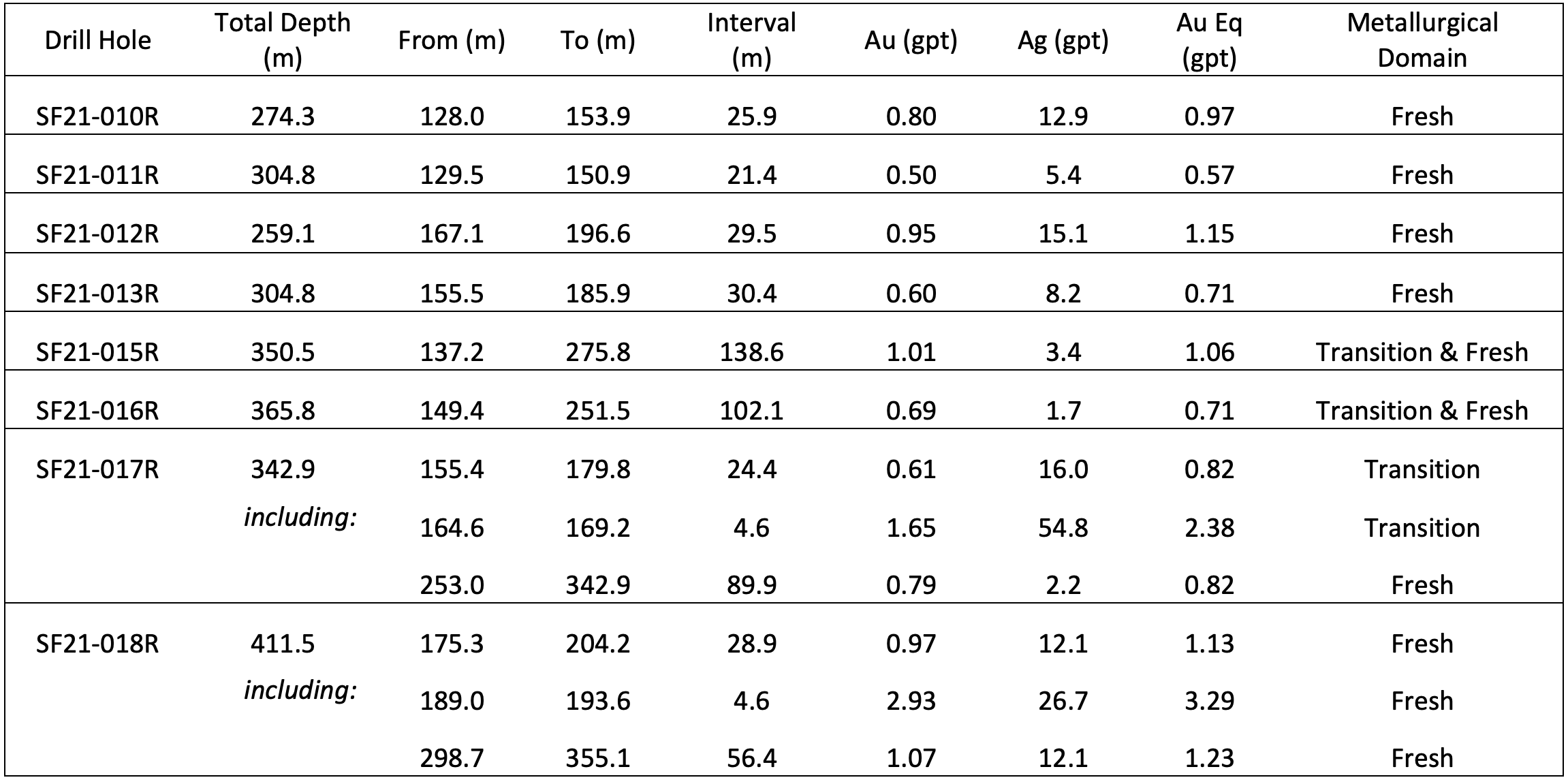

Early in 2021, Lahontan completed its Phase 1A reverse-circulation drilling program totaling 1,218 meters in and around the Santa Fe pit, highlights include:
- • 188.9 meters grading 1.75 gpt Au and 9.9 gpt Ag in drill hole SF21-001R including 56.4 meters grading 2.78 gpt Au and 17.6 gpt Ag and also including 6.1 meters grading 4.29 gpt Au and 31.0 gpt Ag. Gold and silver mineralization starts at the surface and the hole bottomed in mineralized rock.
- • 86.9 meters grading 1.08 gpt Au and 3.7 gpt Ag in drill hole SF21-002R. A complete table of drill results below.
The first portion of the drilling program was centered on the past-producing Santa Fe pit and had two principal objectives: 1) Verify assay data from historic drilling that outlined substantial gold and silver mineralization below and adjacent to the Santa Fe pit; and 2) Confirm metallurgical domains identified by modeling historic drilling, especially at the margins of the deposit. Lahontan believes that early results from the Phase One drilling program is already achieving these objectives.
Drill holes SF21-001R and -002R were collared in the Santa Fe pit and targeted portions of the high-grade BH Zone. Both drill holes intercepted extensive thicknesses of gold and silver mineralization with structurally controlled, higher-grade intervals that characterize the BH Zone as seen in the cross section and plan view to the right.
The assay results compare favorably with nearby historic drill holes giving confidence in the use of historic data in future resource estimates. The 0.1 gpt outline of gold mineralization, based on modeling of historic drill holes and shown in red in the cross section above, corresponds with thick intervals of gold mineralization seen in drill holes SF21-001R and -002R. The high silver grades are also similar to historic drill results and previous mine production, underscoring the potential for important silver by-product credits in any future mining operation.
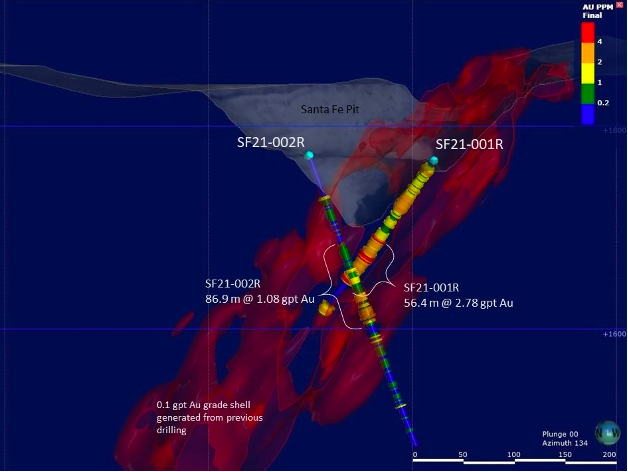

As part of the systematic organization of the drill campaign, drill holes SF21-003R through -006R were collared at the margins of the known gold and silver deposit to confirm depths of oxidation (metallurgical domains) and test the limits of mineralization. Drill holes SF-003R and -004R both intercepted low-grade gold and silver mineralization: 19.9 meters grading 1.04 gpt Au and 2.3 gpt Ag in -003R and 22.8 meters grading 0.51 gpt Au and 4.5 gpt Ag in -004R. Unfortunately, drill hole -003R lost circulation prior to reaching its targeted depth. Drill holes SF-005R and -006R did not hit significant gold and silver mineralization, however, when combined with the results from -003R and -004R, these drill holes show that the depth of oxidation below the central and northwest portions of the Santa Fe pit is somewhat deeper than what was modeled using historic drill holes and that extensive volumes of oxidized gold and silver mineralization remain unmined.
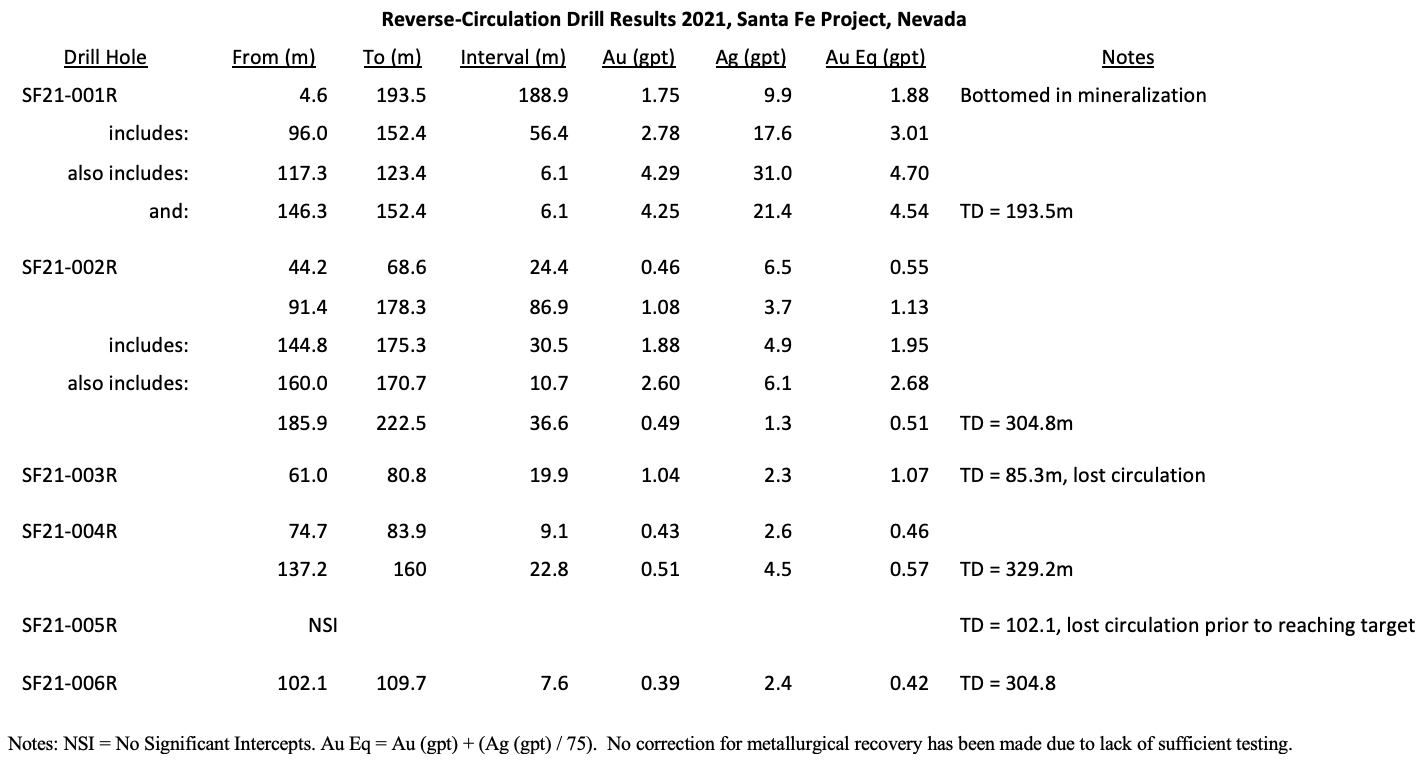
Phase 1B consists of five core holes, totaling 1,421 metres. These core drill holes explored down-rake and on-strike extensions to the high-grade BH Zone and shallow, potentially open pit minable, Au and Ag mineralization southeast of the Santa Fe open pit. High-grade intercepts from the BH Zone include:
- • 3.0 meters grading 2.96 gpt Au and 62.2 gpt Ag (3.79 gpt Au Eq), including 37.3m grading 3.78 gpt Au and 96.1 gpt Ag (5.06 gpt Au Eq), also including 4.9m grading 10.76 gpt Au and 126.7 gpt Ag (12.45 gpt Au Eq) in drill hole SF21-004C.
Highlights from shallow oxide drilling include:
- • 0.9m grading 0.84 gpt Au and 4.6 gpt Ag (0.90 Au Eq), and 20.7m grading 0.45 gpt Au and 3.4 gpt Ag (0.50 gpt Au Eq) in drill hole SF21-004C
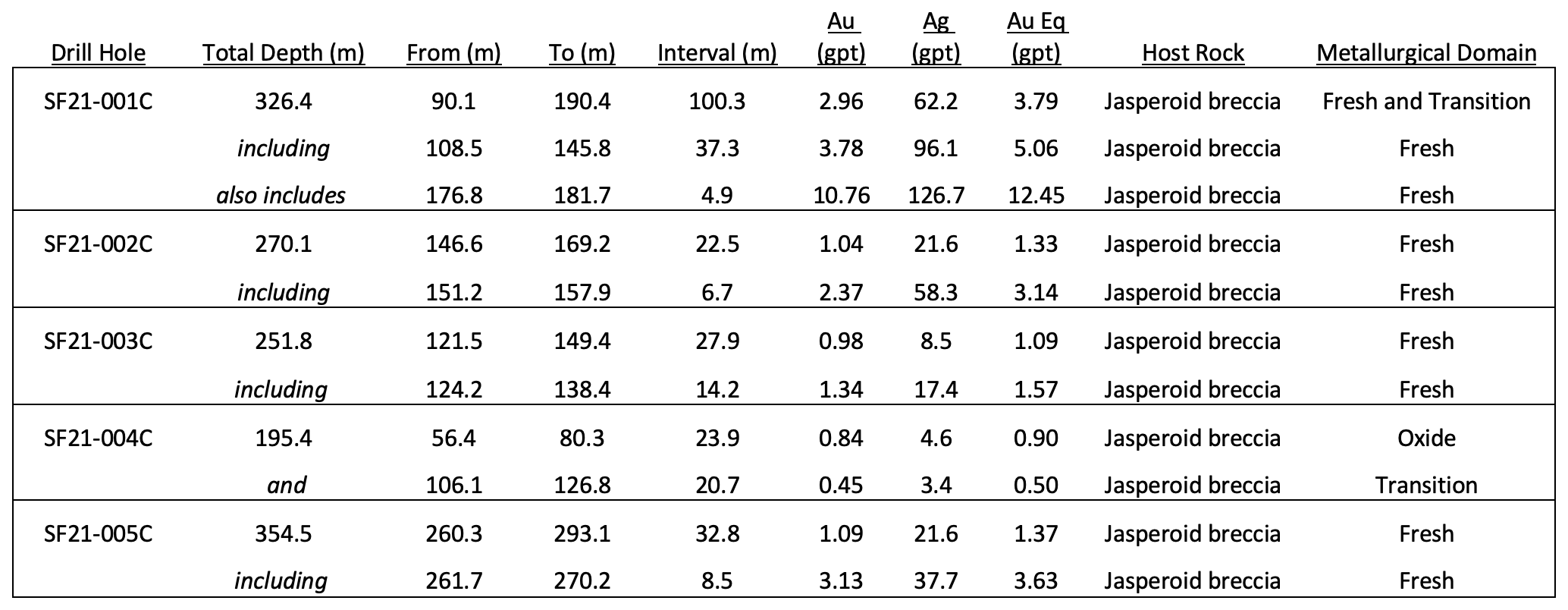
BH Zone: Core drill holes SF21-001C, -002C, and -003C all targeted portions of the BH Zone with different objectives. SF21-001C was oriented to the southeast and angled to test a down-rake portion of the BH Zone and verify continuity of high-grade Au and Ag mineralization similar in tenor and thickness to that seen in historic core drill holes BH-3 and BH-6 drilled by Victoria Gold in 2009 and 2010 respectively. SF21-001C expands the volume and thickness of high-grade mineralization, in particular the 4.9 metre interval of 12.45 gpt Au Eq. It is important to note the very high Ag grades which characterize the BH Zone, e.g. 0.8m grading 6.98 gpt Au and 201 gpt Ag (95.5 – 96.3m), 1.25m grading 5.17 gpt Au and 309 gpt Ag (131.64 – 132.89m), and 1.61m grading 15.04 gpt Au and 107.2 gpt Ag (176.78 – 179.22m), please see core photos below. The Company believes that a significant Ag byproduct in potential future mining operations could have an important impact on project economics. The hydrothermal alteration and mineralogy seen in SF21-001C is identical to that seen in previous drill campaigns (Lahontan has all the core, assays, and drill logs from the Victoria core drilling program for comparitive purposes) adding further confidence to the interpreted continuity of high-grade Au and Ag mineralization in the BH Zone.
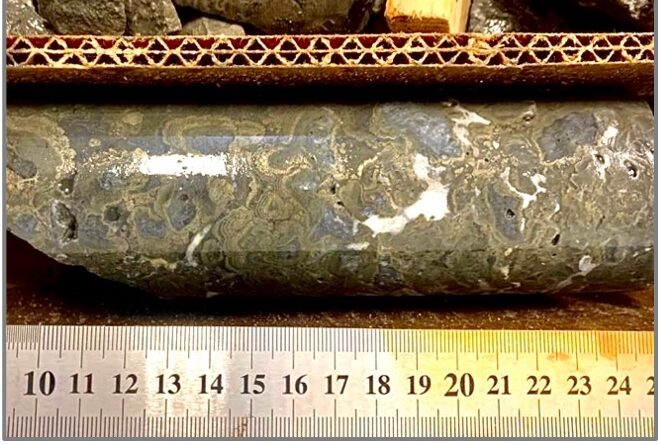


Core drill holes SF21-002C and -003C were collared approximately 150 metres and 245 metres southeast of SF21-001C respectively (please see map above). These drill holes were targeting high-grade, Au and Ag mineralization up-rake and along strike from the main BH Zone. The core drill holes hit significant zones of precious metal mineralization: 6.7m grading 2.37 gpt Au and 58.3 gpt Ag (3.14 gpt Au Eq) in SF21-002C (151.2 – 157.9m) and fill in gaps between historic drill holes (please see cross section below). This mineralization carries the distinctive geochemical signature of the high-grade BH Zone, elevated Ag grades: 1.62 m grading 2.64 gpt Au and 93.9 gpt Ag in SF21-002C (153.62 – 155.24m) and 2.5m grading 2.25 gpt Au and 28.5 gpt Ag in SF21-003C (135.9 – 138.4m).

Based on these drill results and modeling historic drilling, it appears that the BH zone may consist of multiple, repeating or cyclic, down to the southeast raking zones, within the Santa Fe Fault and sympathetic structures. This interpretation greatly expands that target size of the BH Zone, especially given that older drill holes, located hundreds of metres to the south and southeast of SF21-003C have high-grade intercepts that have not been drill tested since the nineties, i.e., reverse-circulation drill hole CSF-89-19 cut 16.8m grading 6.10 gpt Au including 3.3m 11.65 gpt Au. These southeast extensions to the BH Zone have significant, high-grade, resource potential.
Shallow Drilling: Core drill hole SF21-004C targeted shallow Au mineralization to the southeast of the Santa Fe open pit (please see map and cross section above). Historic drilling in this area suggested that shallow, potentially open pit minable, Au and Ag mineralization extended into the target area. SF21-004C cut two intervals of shallow, low-grade Au mineralization with grades within the range that was historically mined at Santa Fe. Importantly, this mineralization occurs in rocks assigned to the oxide and “transitional” metallurgical domains (please see core photo below). The transitional metallurgical domain is characterized as a mixed zone of oxidized and partially oxidized Au mineralization that maybe cyanide extractable. Several additional reverse-circulation drill holes were completed late in 2021 in the vicinity of SF21-004C, results from these drill holes are expected shortly.
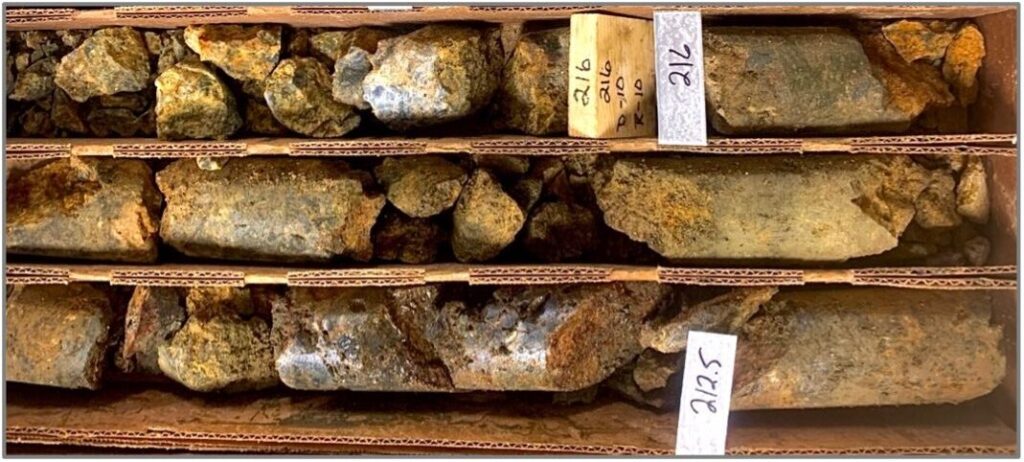
Phase 1C consists of four core drill holes, totaling 891 metres, that were completed in late 2021 and targeted down-dip extensions of oxidized gold and silver mineralization below the Slab open pit in an area where historic drilling outlined significant potential oxide resources. Highlights include:
- • 41.1 metres grading 0.54 gpt Au and 1.8 gpt Ag (0.56 gpt Au Eq) starting at only 52.4 metres down-hole, and a second vertically stacked zone of 19.5 metres grading 0.26 gpt Au and 5.6 gpt Ag (0.33 gpt Au Eq), all oxidized, in drill hole CAL21-002C.
- • 26.7 metres grading 0.44 gpt Au and 3.1 gpt Ag (0.48 gpt Au Eq) starting at only 29.4 metres down-hole, and a second, deeper zone, grading 0.21 gpt Au and 1.5 gpt Ag (0.23 gpt Au Eq), all oxidized, in drill hole CAL21-005C.
These four drill holes intercepted oxidized gold and silver mineralization throughout their entire lengths to a maximum down-hole depth of 246 metres, confirming the presence of widespread oxide mineralization in the Slab pit area with only very minor amounts of transitional mineralization. Of critical importance, the drilling identified at least two vertically stacked zones of gold and silver mineralization; the deeper zone can help drive a deeper pit shell during resource estimation and optimization, which increases the volume of potential resources in the Slab pit area (please see long section).
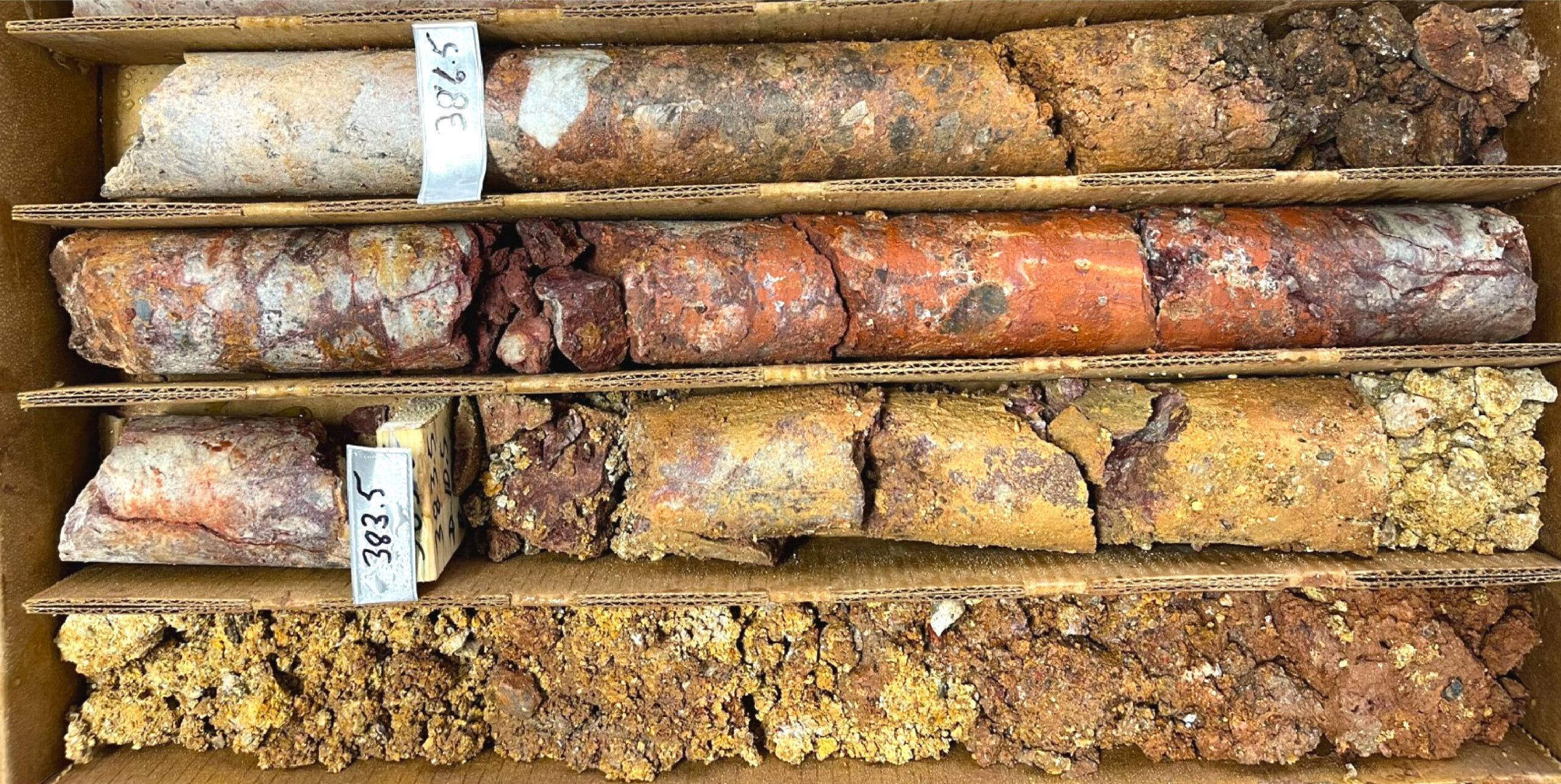
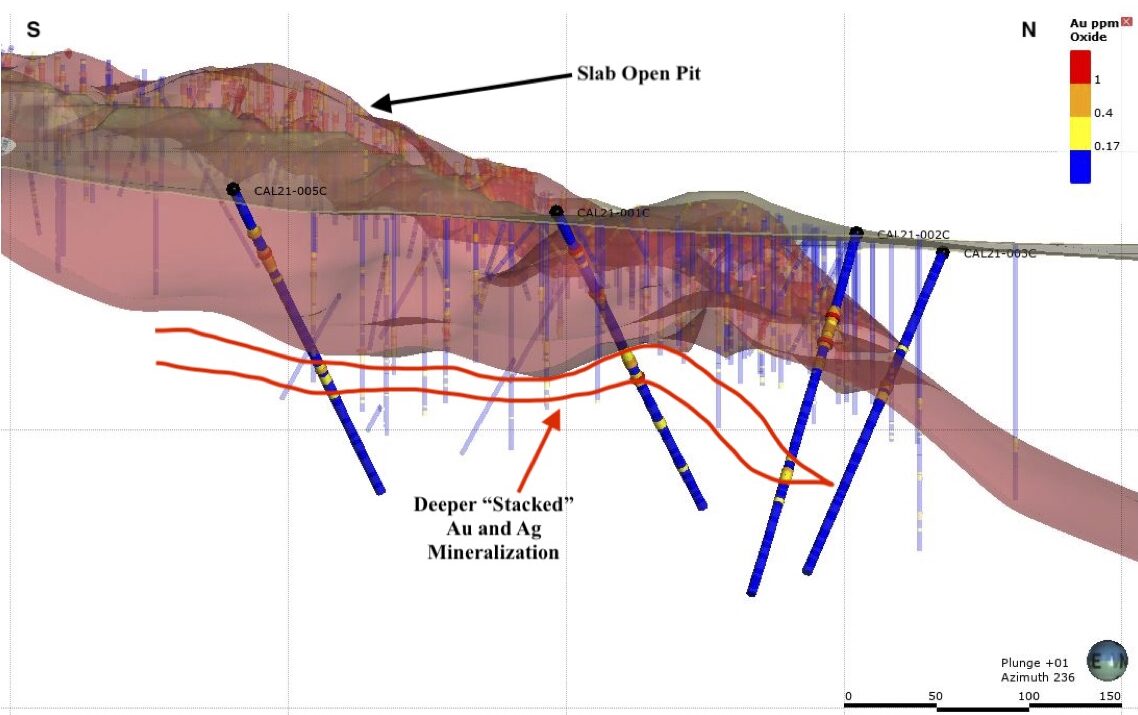
South-north (left to right, please see map below) long section through the Slab pit area, Santa Fe Project, Mineral County, Nevada. The grade shell outlining gold and silver mineralization (shown in pink above) is based upon modeling historic drilling, projected into the line of the long section, now confirmed and expanded by Lahontan drilling.
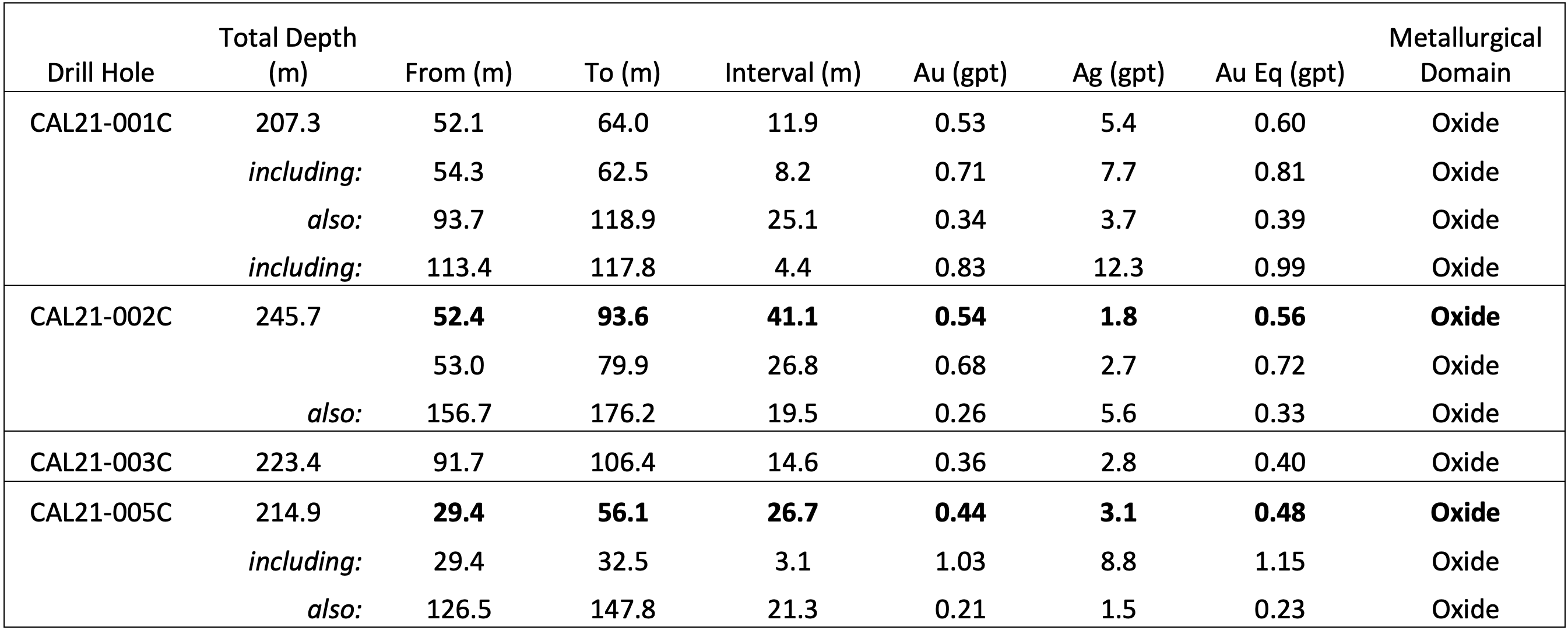

Phase 1D consists of four core drill holes, totaling 1,549 metres, that were completed in late 2021 and targeted down-dip step outs from known gold and silver mineralization along the Santa Fe fault, extensions of oxide and transition mineralization southeast of the Santa Fe pit, and an easterly trending structure that may tie Slab pit mineralization to the Santa Fe pit area. Highlights include:
- • SF21-006c: This core drill hole intercepted continuous gold and silver mineralization over 226 metres (1.22 gpt Au) and the drill hole bottoms in mineralized rock. Within this intercept, Lahontan has discovered a new high-grade zone (the “Bighorn Zone”) with the highest Au assays in project history: up to 26.2 gpt Au and 61.0 gpt Ag (27.01 gpt Au Eq, 245.5 – 246.6m; please see table below). This high-grade zone is separate from the BH Zone and suggests that multiple high-grade feeder zones are present at the Santa Fe Project.
- • SF21-008c: A step-out drill hole southeast of the Santa Fe pit, has successfully intercepted shallow oxidized gold and silver mineralization (75 metres south of previously reported drill hole SF21-004c). This drill hole demonstrates that additional oxide and transition mineralization is extensive south and southeast of the Santa Fe pit, and underscores the resource potential of this area.
- • SF21-007c and -009c: These two core drill holes targeted the projected extension of the Calvada fault, an east-west trending structure that may tie together mineralization seen at the Slab-Calvada area with the intensely gold and silver mineralized Santa Fe pit area. SF21-007c intercepted 64 metres grading 0.74 gpt Au Eq (please see table below) including up to 2.24 gpt Au Eq in transitional rocks (360.6 – 362.1m, 1.97 gpt Au and 19.7 gpt Ag). Although -009c appears to have drilled over the main structure, the two holes confirm the potential of the Calvada fault zone between the Santa Fe and Slab pits opening up over 1000 metres of potentially mineralized structure.

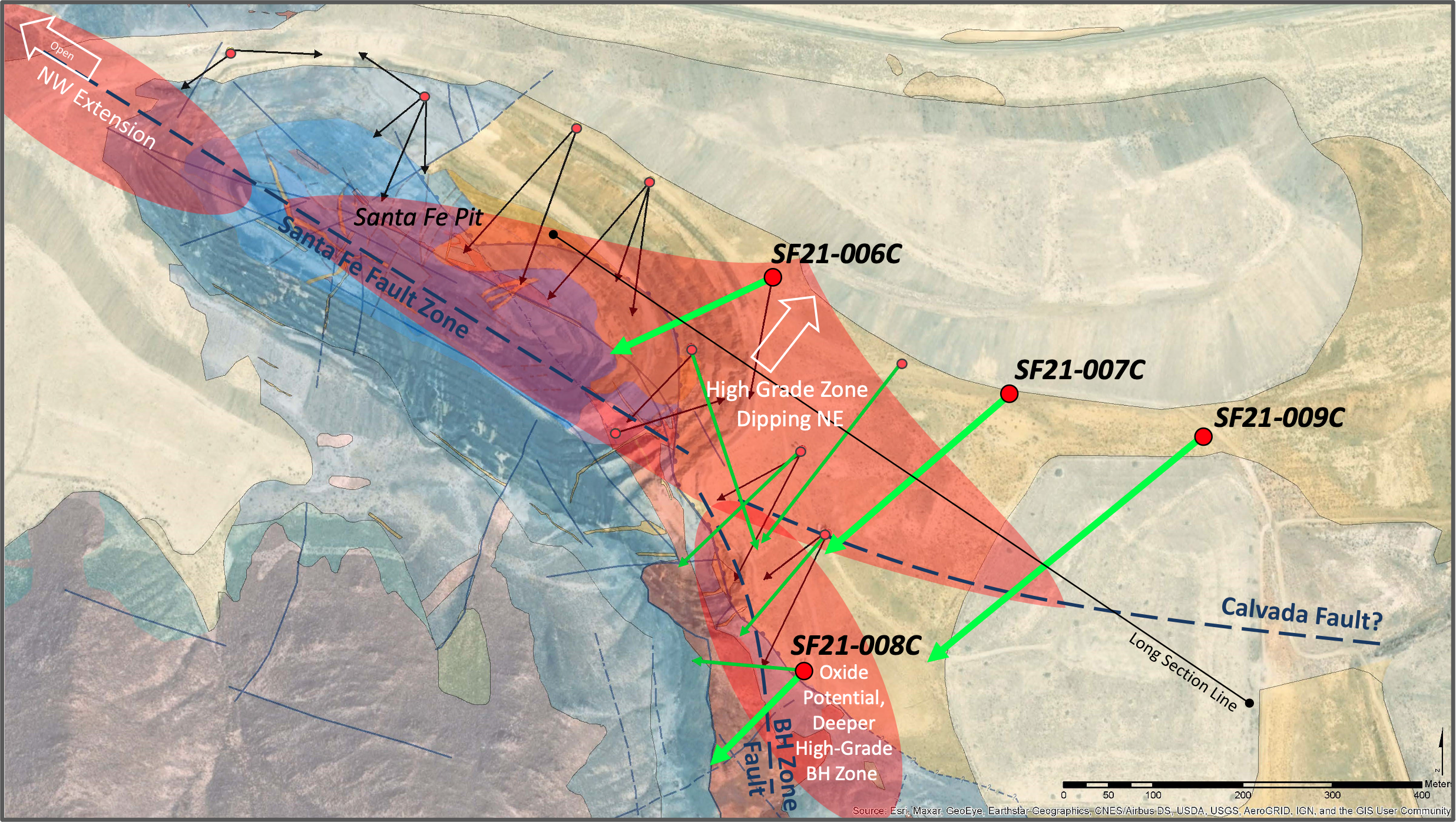
The latest drill results emphasize the importance of both structural and stratigraphic controls to precious metal mineralization at Santa Fe. It is now apparent that structural intersections, e.g. the Santa Fe fault and easterly-tending faults and splays like the Calvada fault, help localize high grades along their raking intersections. Lahontan will apply this interpretation to further drilling northwest of SF21-006c (please see map above). The entire drilled interval of Triassic Luning Formation limestone was mineralized in SF21-006c and the hole bottomed in mineralized rock. Gold and silver mineralization occurs over tens of square kilometres at Santa Fe. The combined areal and vertical distribution of mineralization points to a very large system with multiple targets, both under cover and on the surface that remain to be tested.
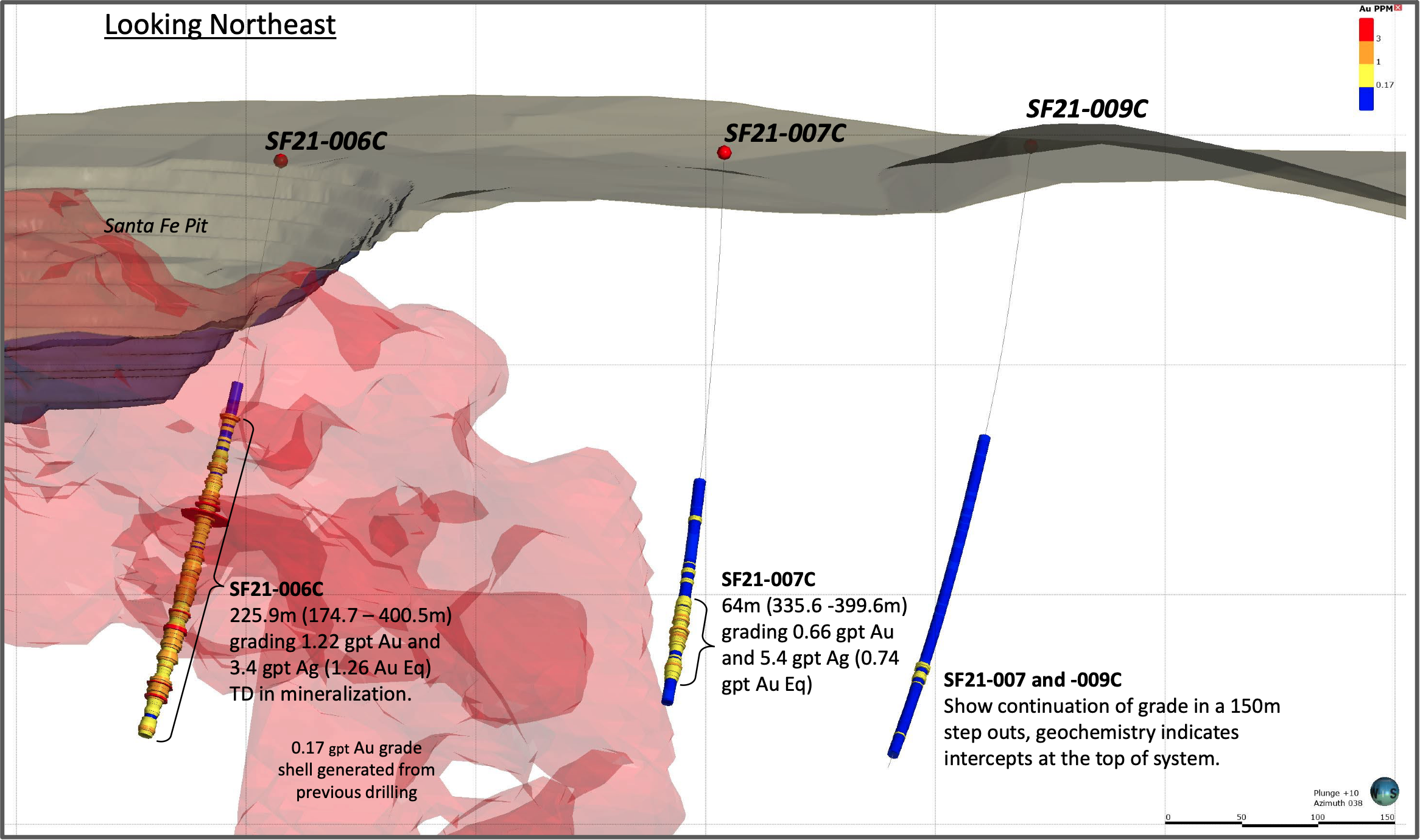
Phase 1E consists of two drill holes, totaling 518.2 metres, which were completed in late 2021. These drill holes targeted northwest and down-dip step outs from known gold and silver mineralization along the Santa Fe fault. Highlights include:
- • SF21-014R: This RC drill hole is located approximately 350 metres northwest of the newly discovered Big Horn high-grade zone and intercepted yet another area of high-grade gold mineralization: 25.9 metre interval grading 20.36 gpt Au (please see table and map below). This newly discovered high-grade zone, called “Bonanza”, has set a new standard with the highest-grade Au assays in project history: 4.6m grading 112.3 gpt Au. The Company has now identified three distinct high-grade gold zones along nearly 800 metres of strike length on the Santa Fe fault that remain open at depth and to the northwest.
- • SF21-009R: This hole was drilled from the same site as SF21-014R and intercepted shallow transition and oxide gold mineralization: 1m grading 1.07 gpt Au, expanding the envelope of oxide and transition mineralization in this corner of the Santa Fe pit and producing new targets for further step-out drilling.

The upper portion of SF21-014R and -009R both intercepted shallow oxide and transition mineralization expanding the envelope of oxide and transition mineralization in this corner of the pit and produce new targets for further step-out drilling (please see cross section below).
The discovery of a third high-grade zone, with the highest gold grades seen to date at Santa Fe, is a significant development for the Company. Potential future mining of these high-grade zones requires that significant tonnages must be discovered, with three distinct high-grade zones already identified, rock volumes in these zones continue to grow. It should be noted that the high-grade intercepts in SF21-014R are approximately 140 metres below the bottom of the Santa Fe pit and therefore easily accessible (please see cross section below). In the Bonanza high-grade zone, two previous drill holes were drilled above the high-grade zone and missed the target, highlighting the value of “deeper” drilling.
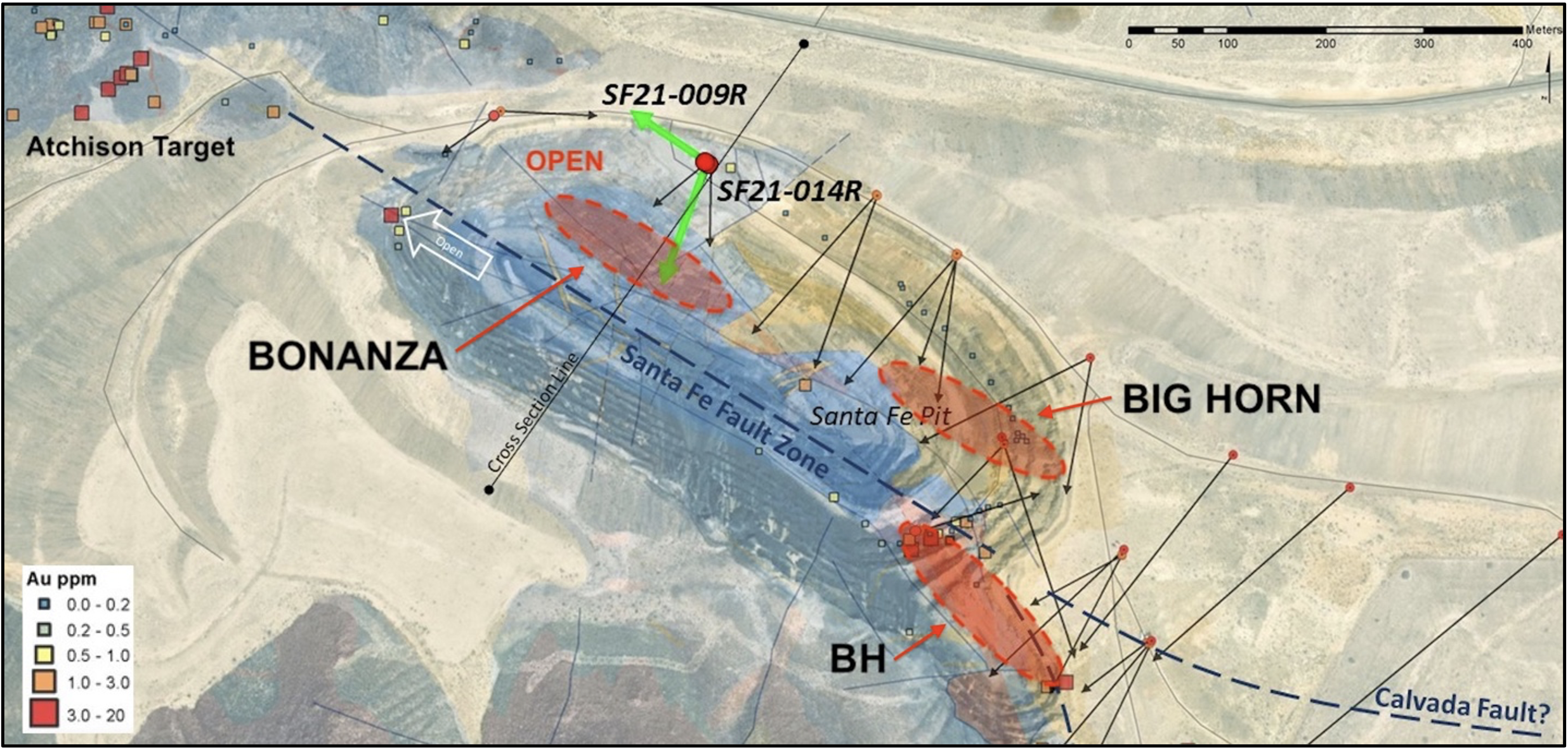
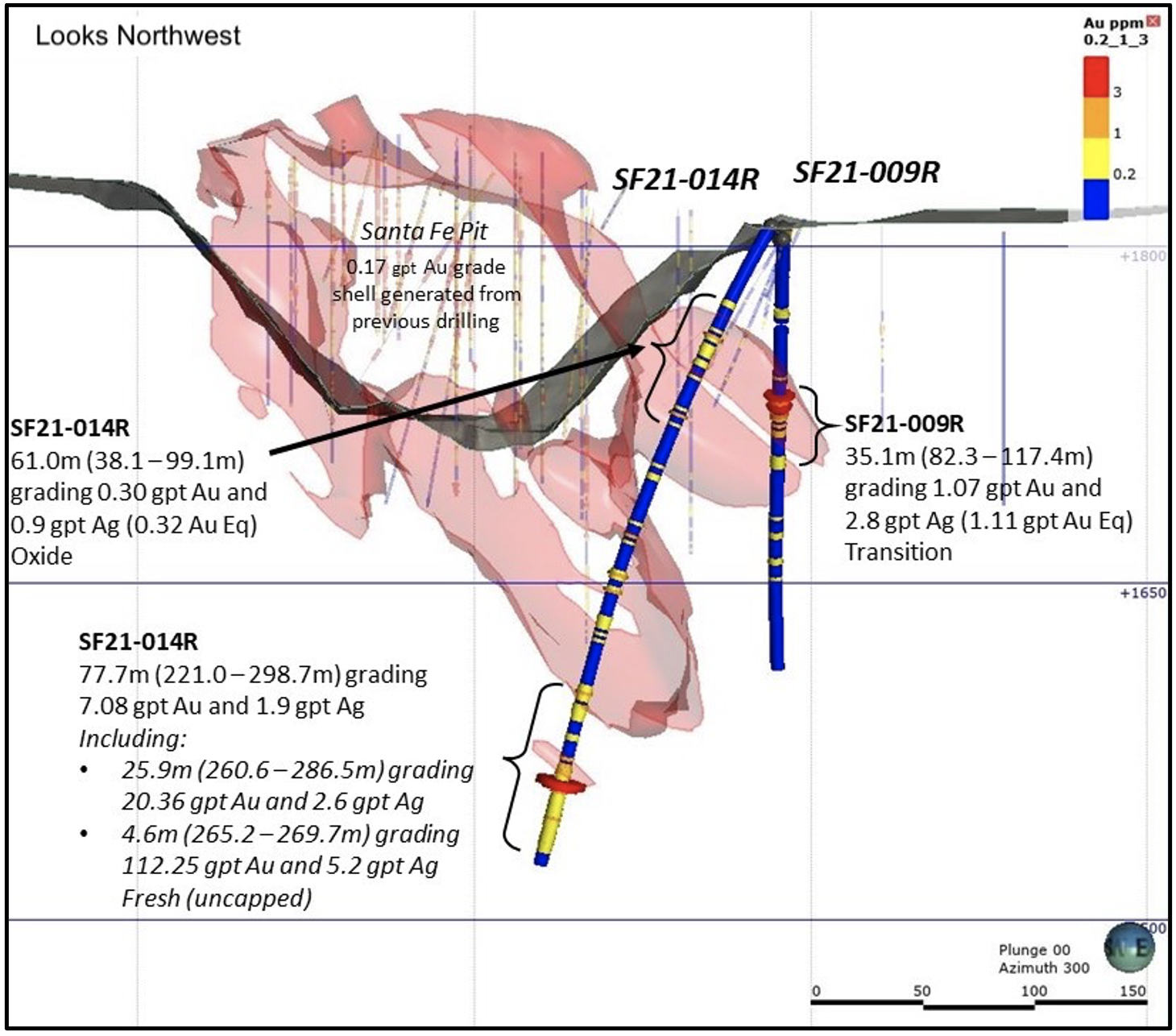
To the northwest, outside of the pit, additional structural targets have been developed, in search of the next high-grade zone along the Santa Fe fault (please see map above). In this area, termed the “Atchison” target, high grade surface rock-chip samples and historic soil sampling highlight another structural intersection between easterly and northwest-trending faults. Drilling of this potential high-grade target is planned for this summer.
Phase 1F consists of three drill holes, totaling 552 metres, that were completed in late 2021 and targeted down-dip extensions of oxidized gold and silver mineralization along the Calvada fault. Historic drilling in this area outlined significant potential oxide resources. Highlights include:
- • 21.0 metres grading 0.89 gpt Au and 2.7 gpt Ag (0.93 gpt Au Eq) of oxidized mineralization in drill hole CAL21-007C confirming oxidized precious metal mineralization over a vertical range of over 150 metres (please see cross section and table below).
- • 32.1 metres grading 0.54 gpt Au and 3.7 gpt Ag (0.58 gpt Au Eq) starting at a vertical depth of only 60 metres in drill hole CAL21-006C.
These three drill holes intercepted shallow, oxidized gold and silver mineralization along the Calvada fault zone, an east-west trending structure that links the previously mined Slab and Calvada pits (please see map below). Gold and silver mineralization crops out on the surface and now has been traced down-dip over a vertical range of almost 200 metres; mineralization remains open at depth.
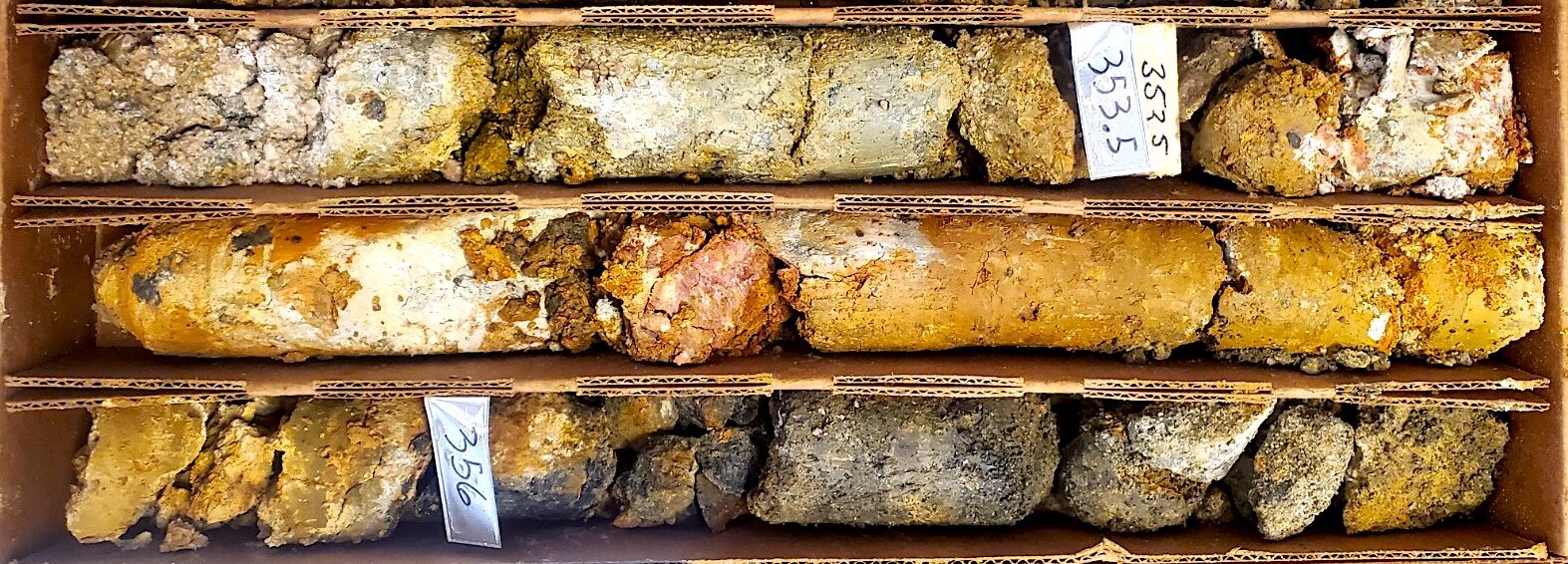
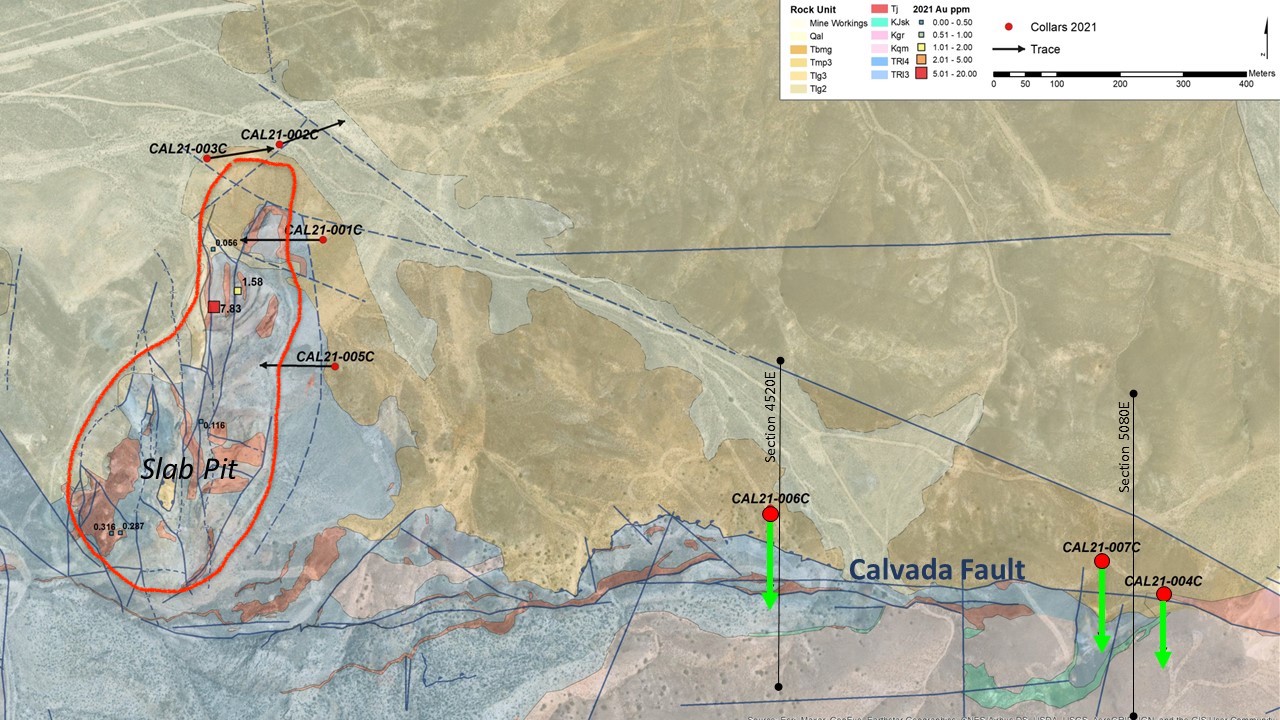

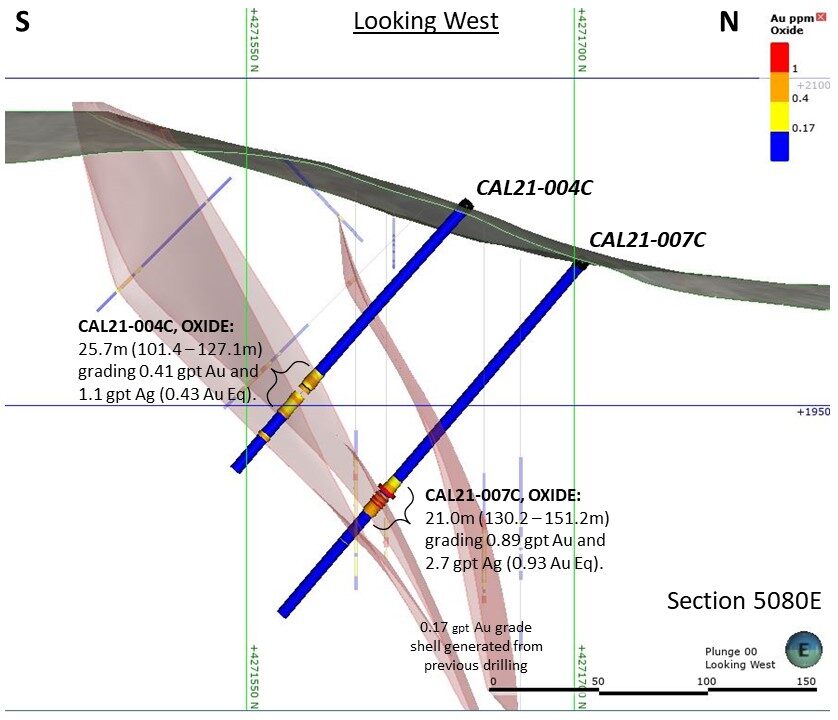
South-north (left to right, please see map above) cross section through drill holes CAL21-004C and -007C in the Calvada Fault zone, Santa Fe Project, Mineral County, Nevada. The grade shell outlining gold and silver mineralization (shown in pink above) is based upon modeling historic drilling, projected into the line of the cross section, now confirmed by Lahontan drilling.
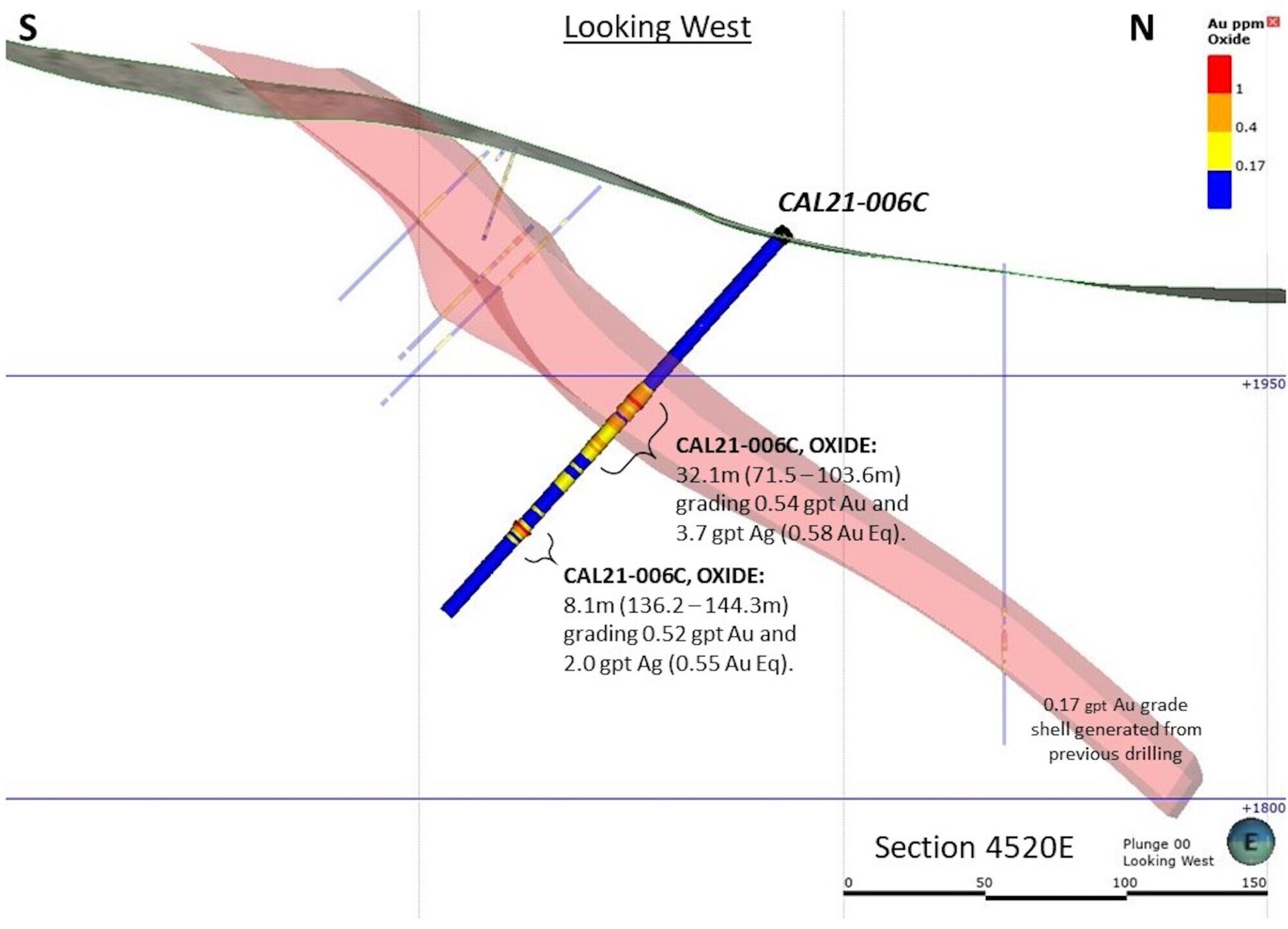
South-north (left to right, please see map above) cross section through drill hole CAL21-006C in the Calvada Fault zone, Santa Fe Project, Mineral County, Nevada. The grade shell outlining gold and silver mineralization (shown in pink above) is based upon modeling historic drilling, projected into the line of the cross section, confirmed and expanded by Lahontan drilling.
Phase 1G consists of eight drill holes, totaling 2,614 metres, are the final RC holes from the 2021 drilling campaign. These drill holes targeted down-dip plus northwest and southeast step outs from known gold and silver mineralization along the Santa Fe fault. Highlights include:
- • SF21-015R and -016R: These two RC drill holes targeted expansion of known mineralization in the high-wall of the Santa Fe Pit between the Bonanza and Big Horn zones and were collared approximately 120 metres northwest of SF21-007R (please see map below). SF21-015R cut 138.6m grading 1.01 gpt Au and 3.4 gpt Ag (1.06 gpt Au Eq) while SF21-016R intercepted 102.1m grading 0.69 gpt Au and 1.7 gpt Ag (0.71 gpt Au Eq). These drill holes expand potential resources in this portion of the Santa Fe pit and define the extent of transitional mineralized rock.
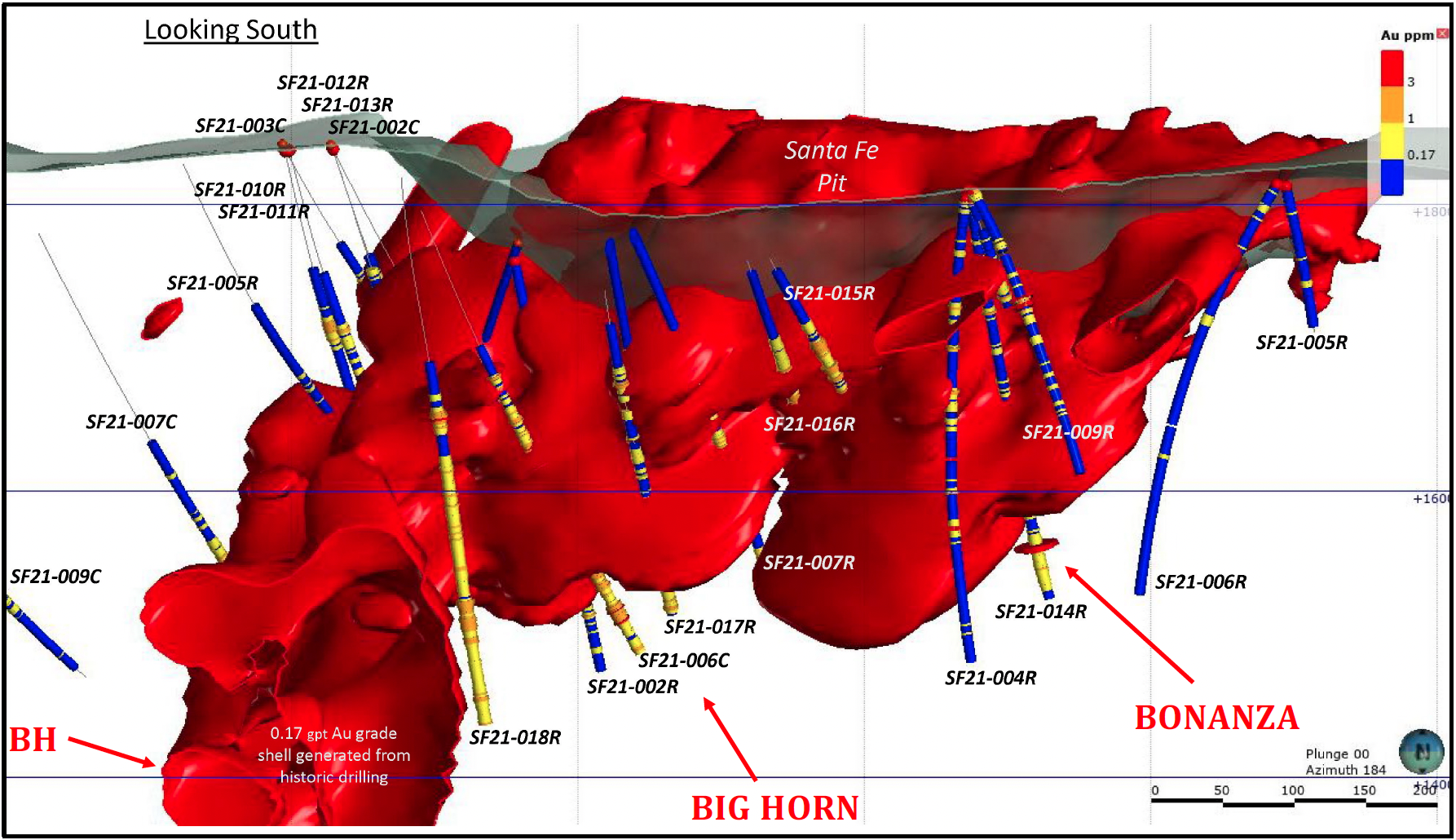
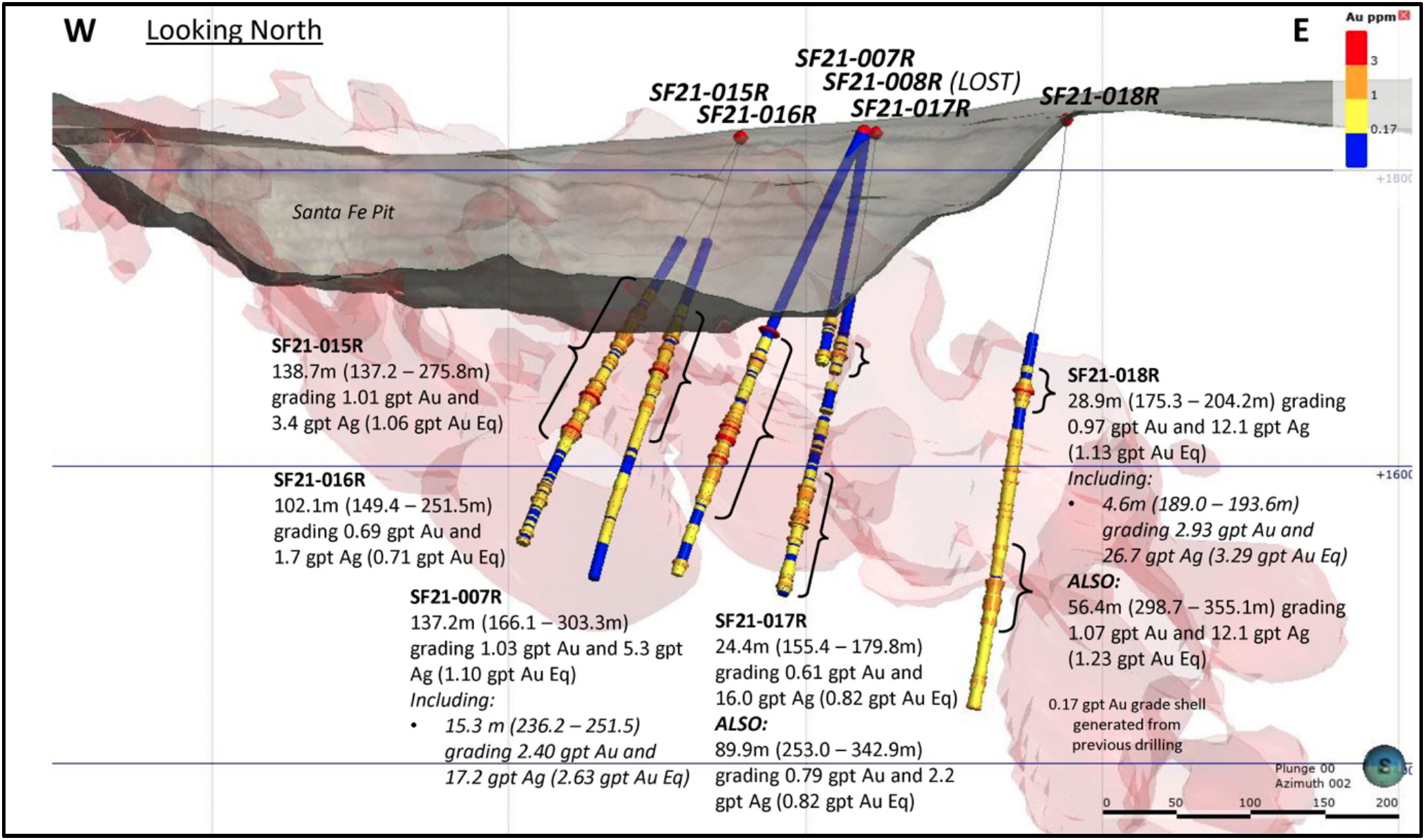
Central Santa Fe Pit Drill Holes: As noted above, RC drill holes, SF21-007R, -008R, -015R through -18R targeted expanding potential resources in the central portion of the Santa Fe pit by stepping out into the pit high-wall. While SF21-008R was lost above the intended target, previously reported drill hole -007R intercepted what may be the edge of more high-grade mineralization: 1.5m grading 3.50 gpt Au and 61.9 gpt Ag (4.33 gpt Au Eq, 240.8 – 242.3m). Drill holes SF21-015R and -016R successfully expanded the volume of transition mineralization between the Big Horn and Bonanza high-grade zone (please see cross sections above). Based on the silver grades, it appears that drill holes SF21-015R and -016R drilled the margins of the Big Horn high-grade zone, confirming tonnage potential of this important high-grade target. Of note, SF21-007R, -015R and -018R all bottomed in mineralized rock, emphasizing that the Santa Fe deposit remains open at depth.
South-Southeast Extension of the Santa Fe Pit: RC drill holes SF21-010R through -013R were drilled to further define the boundaries between transition mineralization and fresh rock south-southeast of the Santa Fe pit. All four drill holes intercepted significant widths of mineralized material and confirmed suspected boundaries of the metallurgical domains in this area.
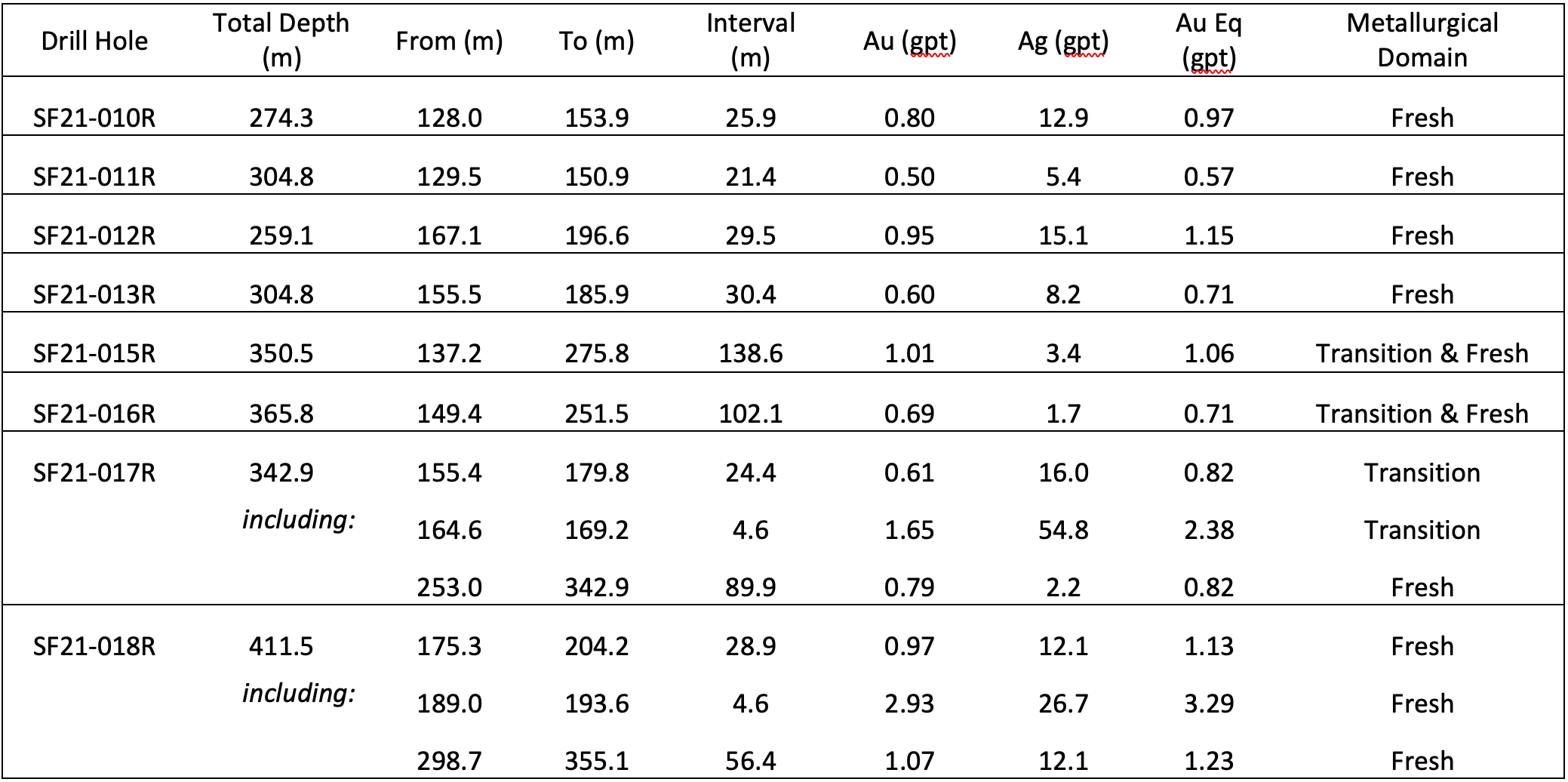
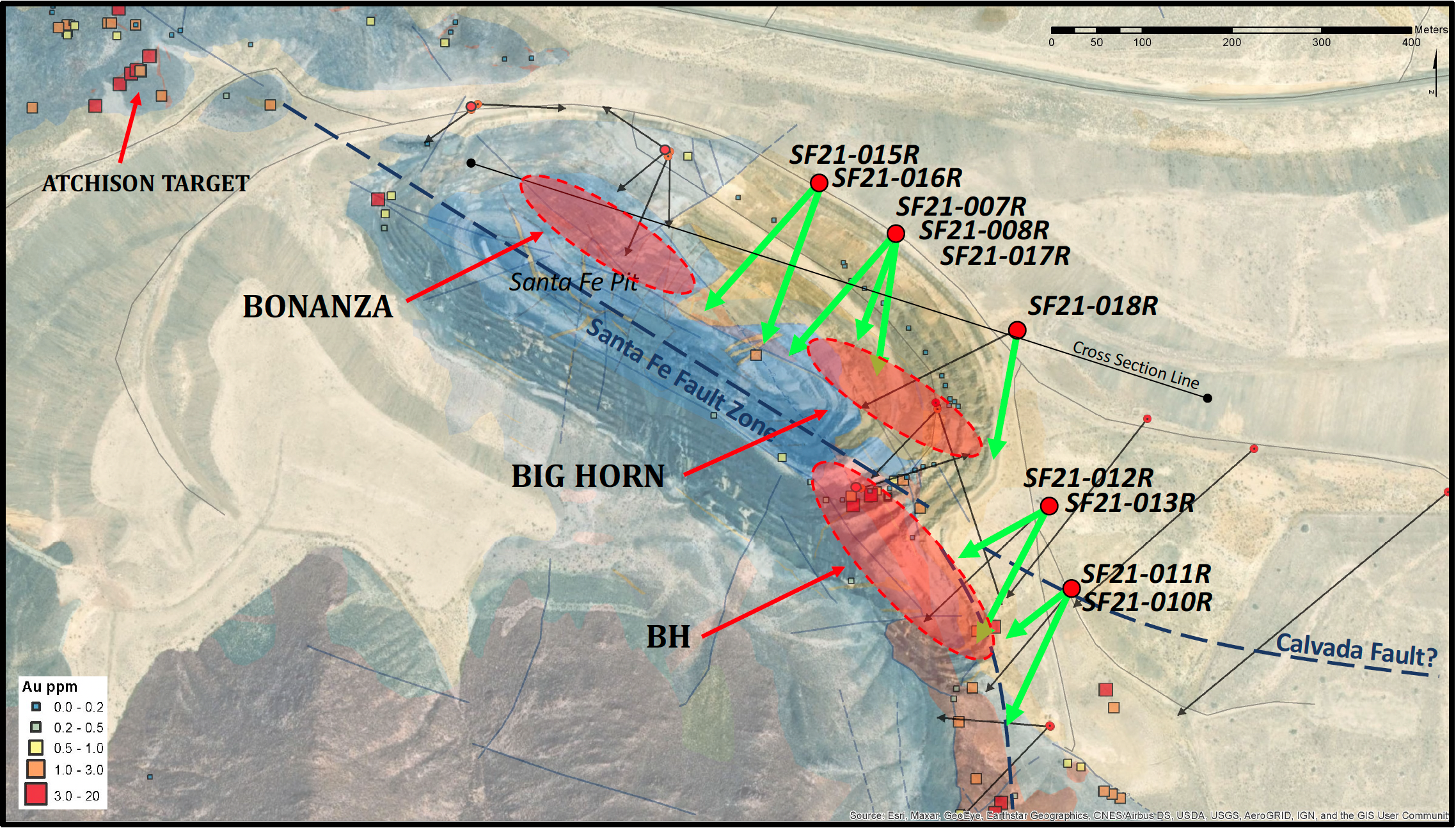
- Phase 2A
- Phase 2B
- Phase 2C
Early in 2022, Lahontan completed its Phase 2A campaign exploring the Slab-Calvada pit area. The seven drill holes, totaling 1,710 metres, targeted down-dip extensions of oxidized gold and silver mineralization along the Calvada fault and northerly step-out drilling from the Slab pit. Historic drilling in both areas had outlined significant potential oxide and transition domain resources. Highlights include:
- • 25.9 metres grading 2.55 gpt Au and 3.4 gpt Ag (2.60 gpt Au Eq) of oxide and transition metallurgical domain mineralization in drill hole CAL22-006R. This is the farthest north step-out drill hole from the Slab pit, with gold mineralization starting at a depth of only 68.6 metres down-hole (please see map and table below).
- • 47.2 metres grading 0.78 gpt Au and 1.3 gpt Ag (0.80 gpt Au Eq) in drill hole CAL22-002R including 32.0 metres grading 1.04 gpt Au and 1.4 gpt Ag (1.06 gpt Au Eq) of oxidized mineralization down-dip along the Calvada fault, further expanding the envelope of oxide gold mineralization along this important structure (please see map, cross section, and table below).
As can be seen in the drill hole location map above, our drone magnetic survey data clearly outlines a magnetic low extending north from the Slab pit. Lahontan’s Phase Two drilling confirms that gold and silver mineralization extends at least 200 metres north of the pit at shallow depths. The magnetic data supports multiple drilling targets north and northwest of the Slab pit as well as along the Calvada fault, highlighting the large resource potential of the Slab-Calvada area.
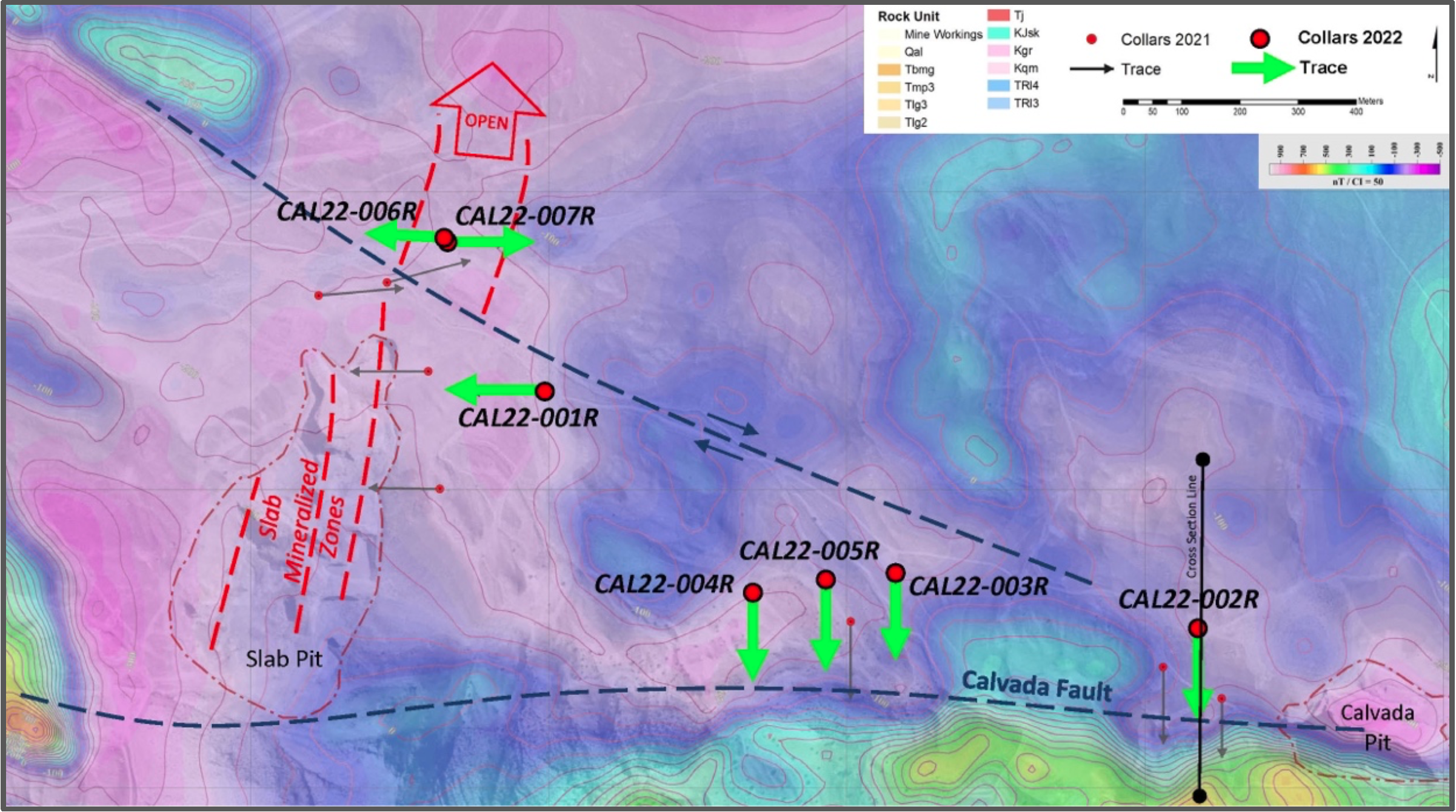
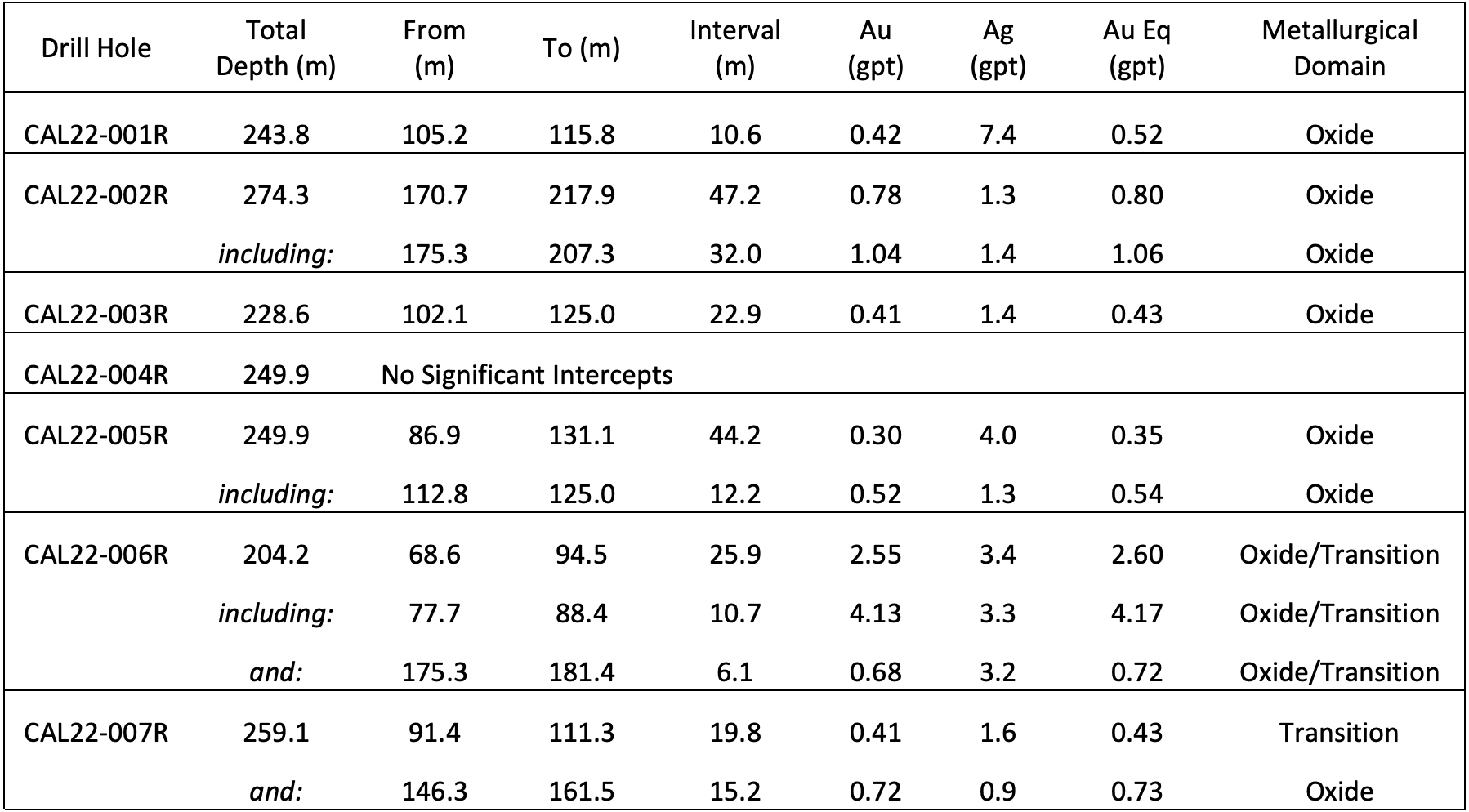
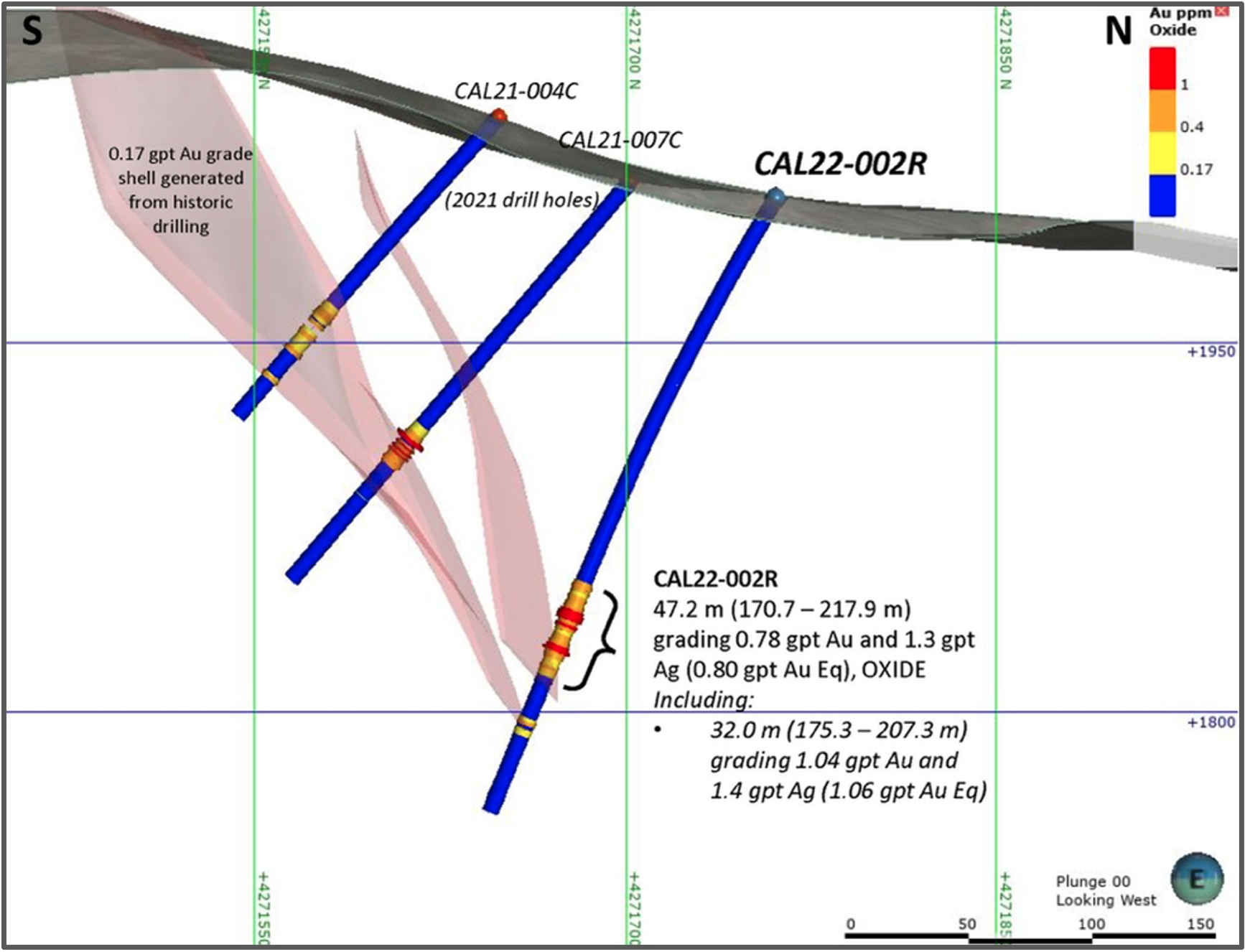
South-north (left to right, please see map above) cross section through drill holes CAL21-004C, -007C, and new drill hole CAL22-002R in the Calvada fault zone, Santa Fe Project, Mineral County, Nevada. The grade shell outlining gold and silver mineralization (shown in pink above) is based upon modeling historic drilling; CAL22-002R greatly expands oxide gold mineralization at depth and confirms the potential for deeper resource expansion drilling along the Calvada fault.
The four drill holes, totaling 883 metres, targeted down-dip extensions of oxidized gold and silver mineralization east and northeast of the Slab pit. Past mining and historic drilling had outlined significant potential oxide and transition domain resources east of the Slab pit that remained open down dip from the pit. Highlights include:
- • 32.0 metres grading 0.50 gpt Au and 7.9 gpt Ag (0.60 gpt Au Eq) of oxide and transition
metallurgical domain mineralization in drill hole CAL22-010R including 10.7 metres grading 0.93 gpt Au and 18.7 gpt Ag (1.18 gpt Au Eq). This drill hole, coupled with earlier Lahontan drill results, confirms a major easternly extension of previously mined gold and silver mineralization seen in the Slab pit, extending mineralization at least 350 metres down dip at shallow levels (please see cross section, location map, and table below).
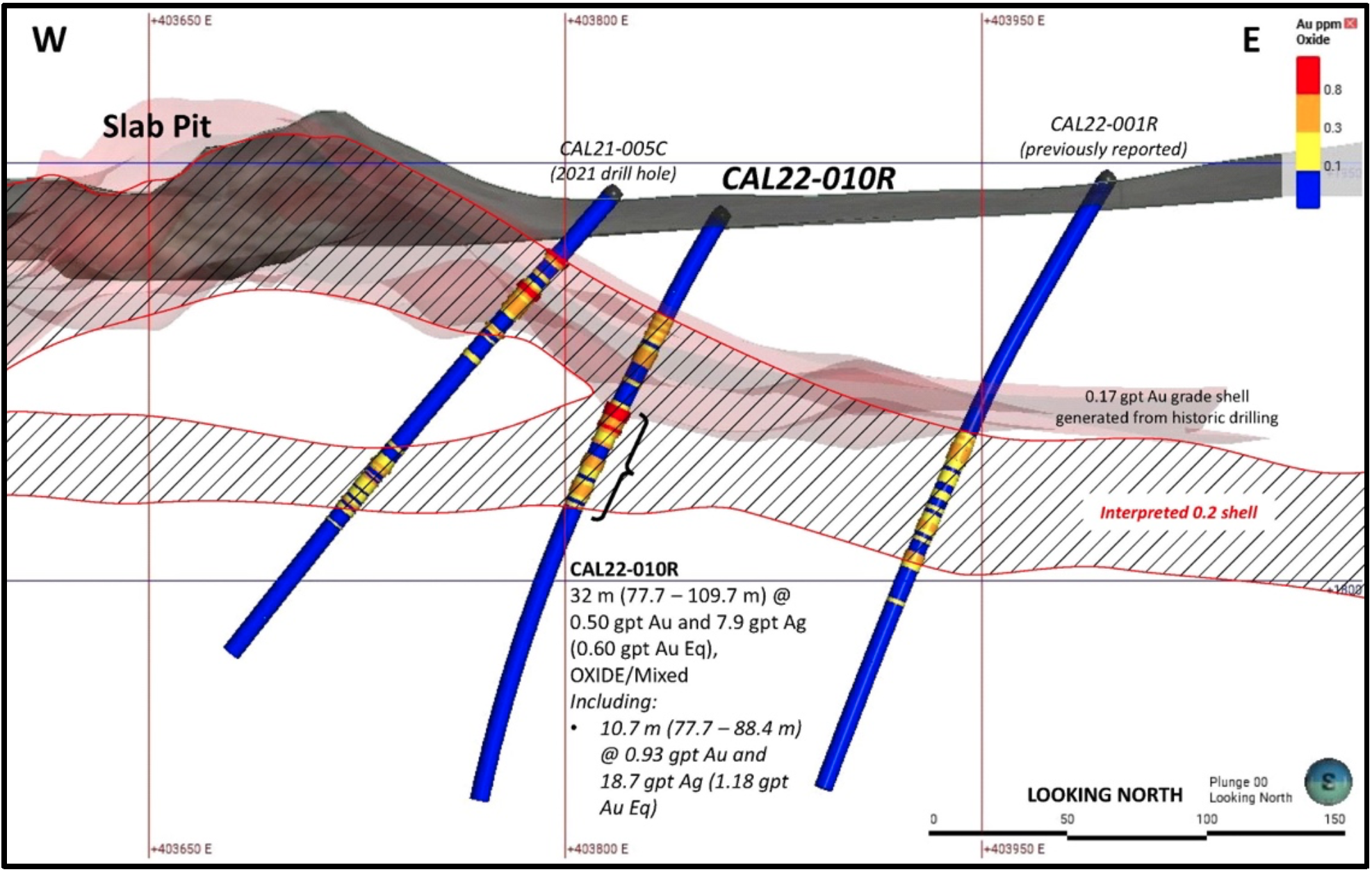

Important take-aways from these drill results include the further confirmation that gold and silver mineralization occurs in areas that are characterized as a magnetic low. As can be seen in the drill hole location map above, there are extensive areas with a low intensity magnetic signature that remain untested by drilling that could host potential resources in the Slab-Calvada area. The drill results table below also highlights an important characteristic of mineralization east and northeast of the Slab pit: higher silver grades. The silver content is significant and could positively impact potential mining operations at Santa Fe.
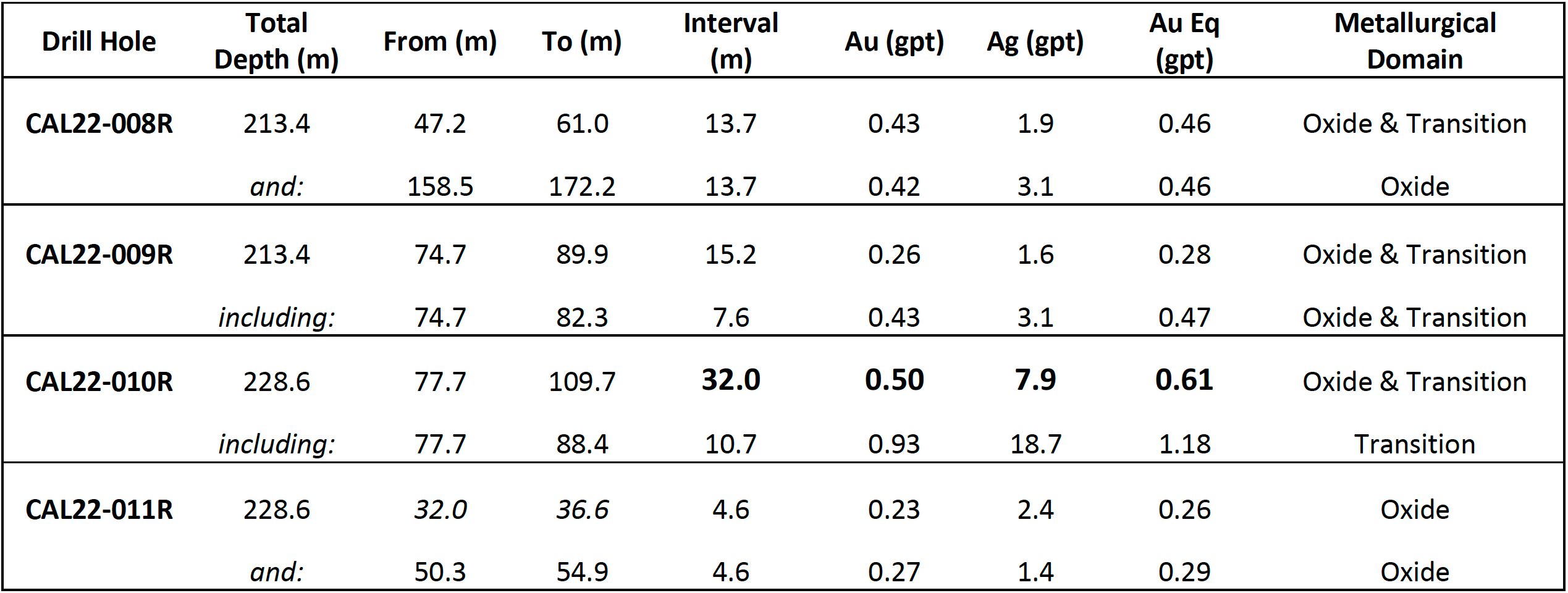
The five drill holes, totaling 1,111 metres, are the final drill holes of the Company’s Phase Two drilling campaign. The drill holes targeted down-dip extensions of oxidized gold and silver mineralization east and northeast of the Slab pit. Past mining and historic drilling had outlined significant potential oxide and transition domain resources east of the Slab pit that remained open down dip from the pit. Highlights include:
- • 32.0 metres grading 0.59 gpt Au and 4.4 gpt Ag (0.65 gpt Au Eq) of oxide and transition metallurgical domain mineralization in drill hole CAL22-016R including 6.1 metres grading 1.18 gpt Au and 14.4 gpt Ag (1.37 gpt Au Eq). This drill hole, coupled with earlier Lahontan drill results, shows that gold and silver mineralization extends in an easterly direction from the Slab pit across a post-mineral fault, opening a large area for resource expansion. (Please see cross section, location map, and table below).
- • 62.5 metres grading 0.33 gpt Au and 2.6 gpt Ag (0.36 gpt Au Eq) of oxide mineralization in drill hole CAL22-015R including 6.1 metres grading 1.04 gpt Au and 1.4 gpt Ag (1.06 gpt Au Eq). This drill hole extends shallow gold and silver mineralization from the southeast corner of the Slab pit, expanding resource potential.

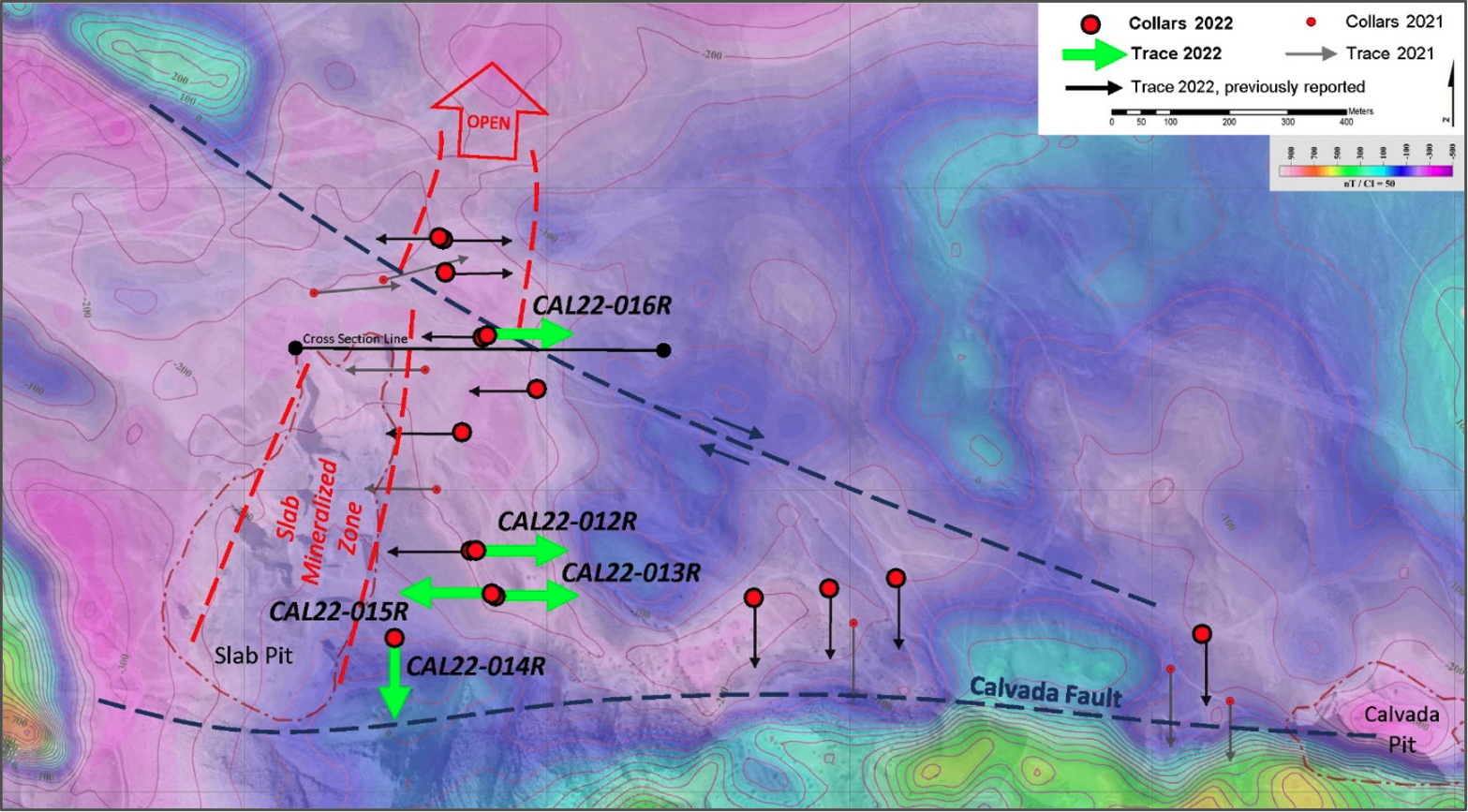
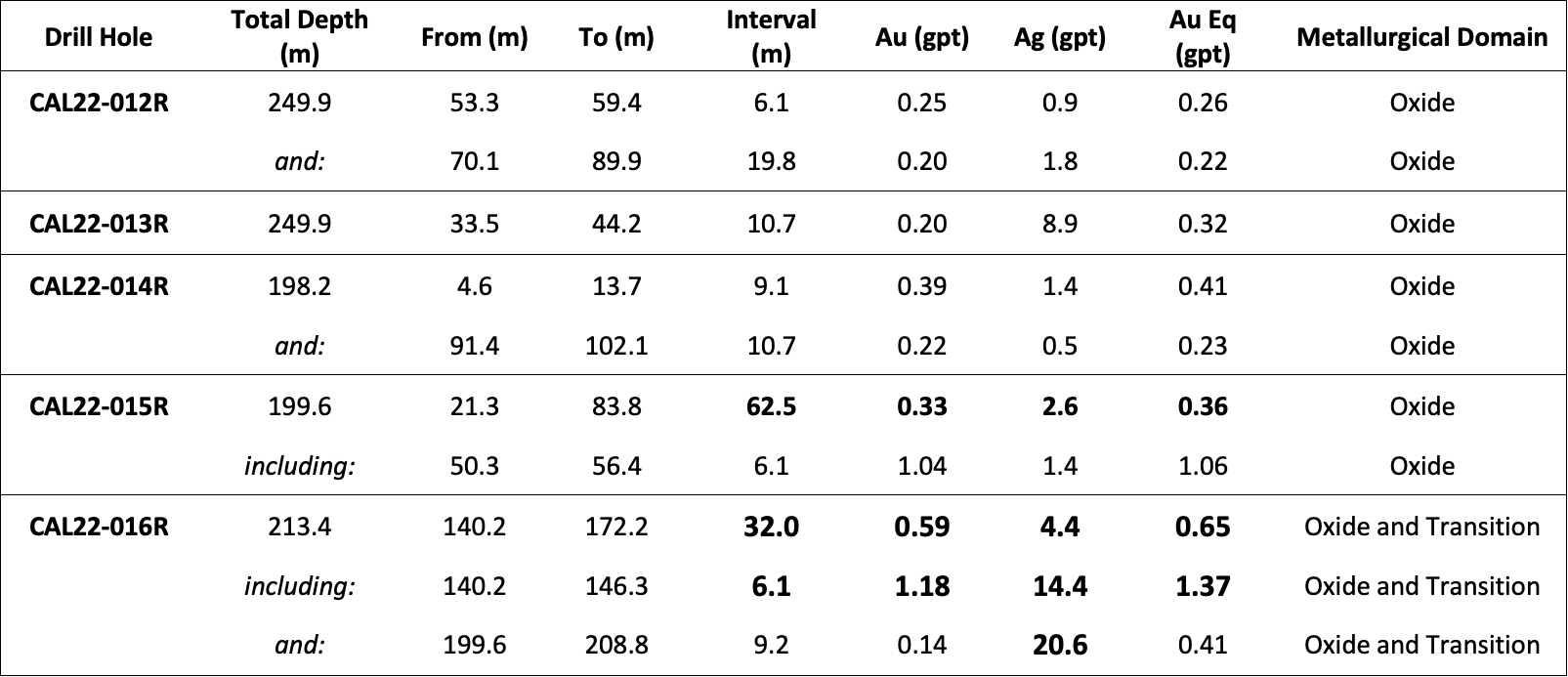
- Phase 3A
- Phase 3B
The first four reverse-circulation rotary (“RC”) drill holes from the Company’s 2023 7,000 metre Phase Three drilling campaign exploring the Calvada pit area of the Company’s 19 km2 Santa Fe Mine Project in Nevada’s Walker Lane. Past mining, historic drilling, and the Company’s previously completed Phase One and Phase Two drilling programs had outlined significant oxide domain gold and silver resources (Canadian NI 43-101 compliant) west of the Calvada open pit that remain open along strike and down-dip*. The four drill holes reported herein, totaling 883 metres, targeted these potential extensions to gold and silver resources. Highlights include:
- • 38.1 metres grading 0.87 g/t Au and 2.5 g/t Ag (0.89 gpt Au Eq) of oxide metallurgical domain mineralization in drill hole CAL23-004R including 10.6 metres grading 2.02 g/t Au and 2.4 g/t Ag (2.04 gpt Au Eq). This drill hole, coupled with earlier Lahontan drill results, shows that oxide gold and silver mineralization extends in a westerly direction from the Calvada pit along the Calvada Fault, a key target area for resource expansion. (Please see location map, cross section, and table below).
- • 82.3 metres grading 0.68 g/t Au and 2.0 g/t (0.70 gpt Au Eq) of oxide metallurgical domain mineralization in drill hole CAL23-001R, including 21.3 metres grading 0.93 gpt Au and 1.9 gpt Ag (0.95 gpt Ag). This thick intercept should help expand the scale of the conceptual pit shell used to constrain mineral resources in future resource estimates. This intercept also contains a higher-grade interval which may be indicative of the margin of a “feeder” structure. Oxide gold and silver mineralization remain open below CAL23-001R generating yet another target for resource expansion at the Santa Fe Mine (Please see cross section below).
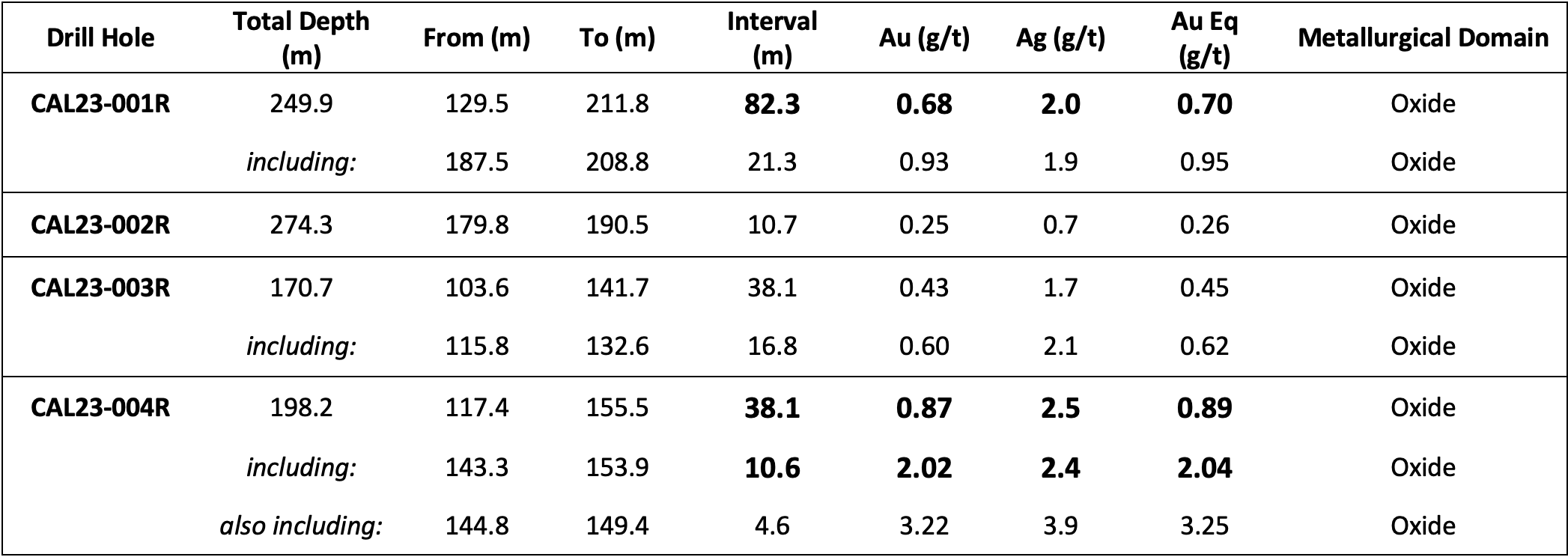
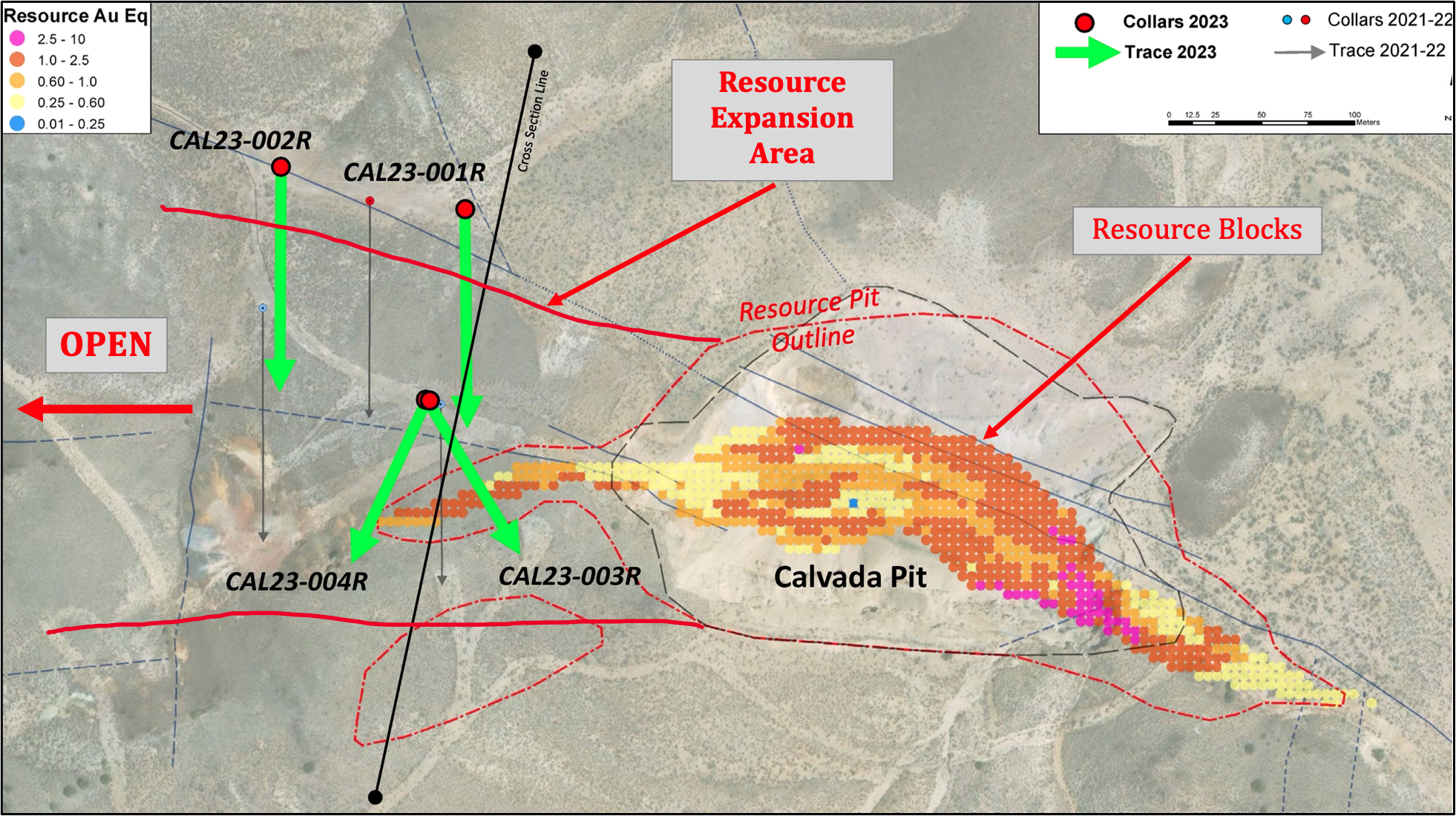
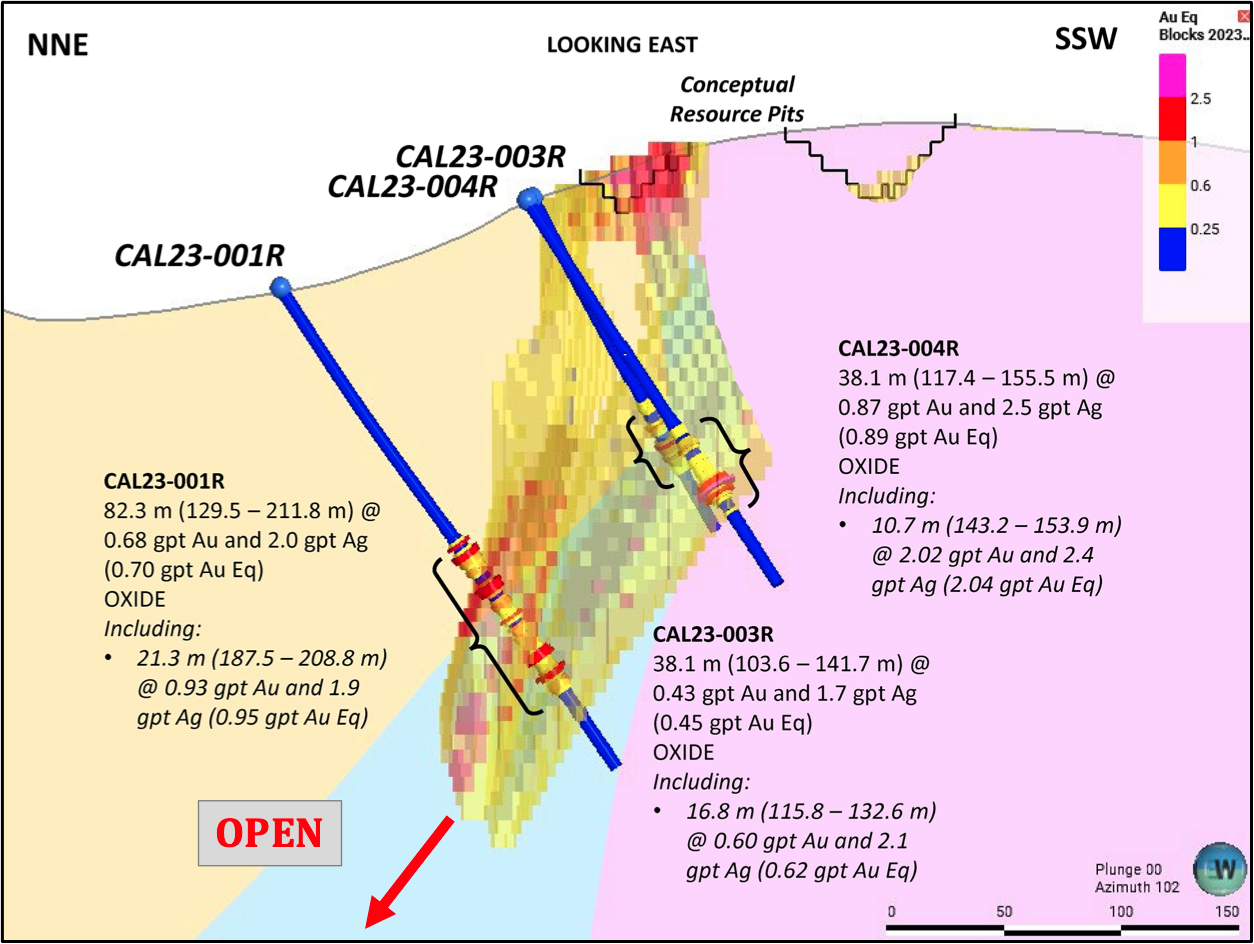
The plan view and cross section of the Calvada pit area (above) highlights the resource expansion potential of the current drilling campaign. All four drill holes intercepted significant oxide gold and silver mineralization, expanding the footprint of the Calvada resource to the west. Mineralization remains open to the west, east and at depth and will be the subject of additional drilling during 2023.
* Please see the Santa Fe Project Technical Report, Authors: Trevor Rabb and Darcy Baker, P. Geos. Effective Date: December 7, 2022, Report Date: March 2, 2023. The Technical Report is available on the Company’s website and SEDAR.
Phase 3B consists of six reverse-circulation rotary (“RC”) drill holes from the Company’s 2023 7,000 metre Phase Three drilling campaign at the Company’s 19 km2 Santa Fe Mine Project in Nevada’s Walker Lane. These drill holes are first exploratory drill holes completed in the York pit area in over 30 years, historic drilling had outlined significant oxide domain gold and silver resources (Canadian NI 43-101 compliant) that remained open along strike and down-dip*. The six drill holes reported herein, totaling 1,271 metres, targeted potential extensions to these gold and silver resources. Highlights include:
- • 5 metres grading 0.74 g/t Au and 0.5 g/t Ag (0.74 g/t Au Eq) of oxide metallurgical domain mineralization in drill hole YOR23-006R including 10.7 metres grading 1.01 g/t Au and 1.9 g/t Ag (1.03 g/t Au Eq). This drill hole shows that oxide gold and silver mineralization extends below the York pit and opens the entire York area for resource expansion (please see location map, cross section, and table below).
- • The York drill holes intercepted significant widths of oxide and transition metallurgical domain gold and silver mineralization below and east of the Mineral Resource Estimate (“MRE”) conceptual pit shell and the as-mined York pit. The York drill holes confirm the historic drill data and will greatly expand the scale of the conceptual pit shell used to constrain mineral resources in future resource estimates (note the small size of the conceptual pit shell in the cross section below).
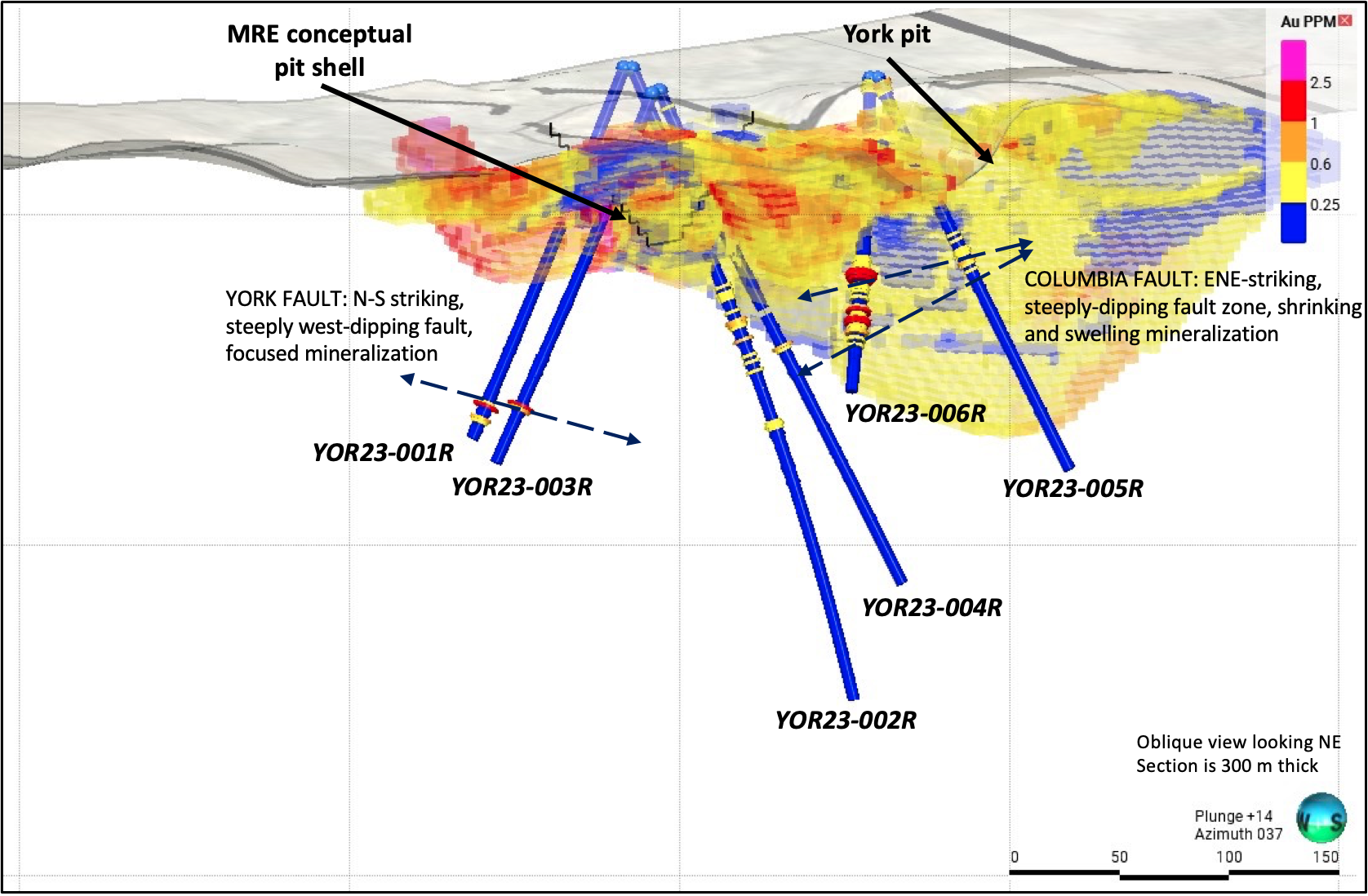
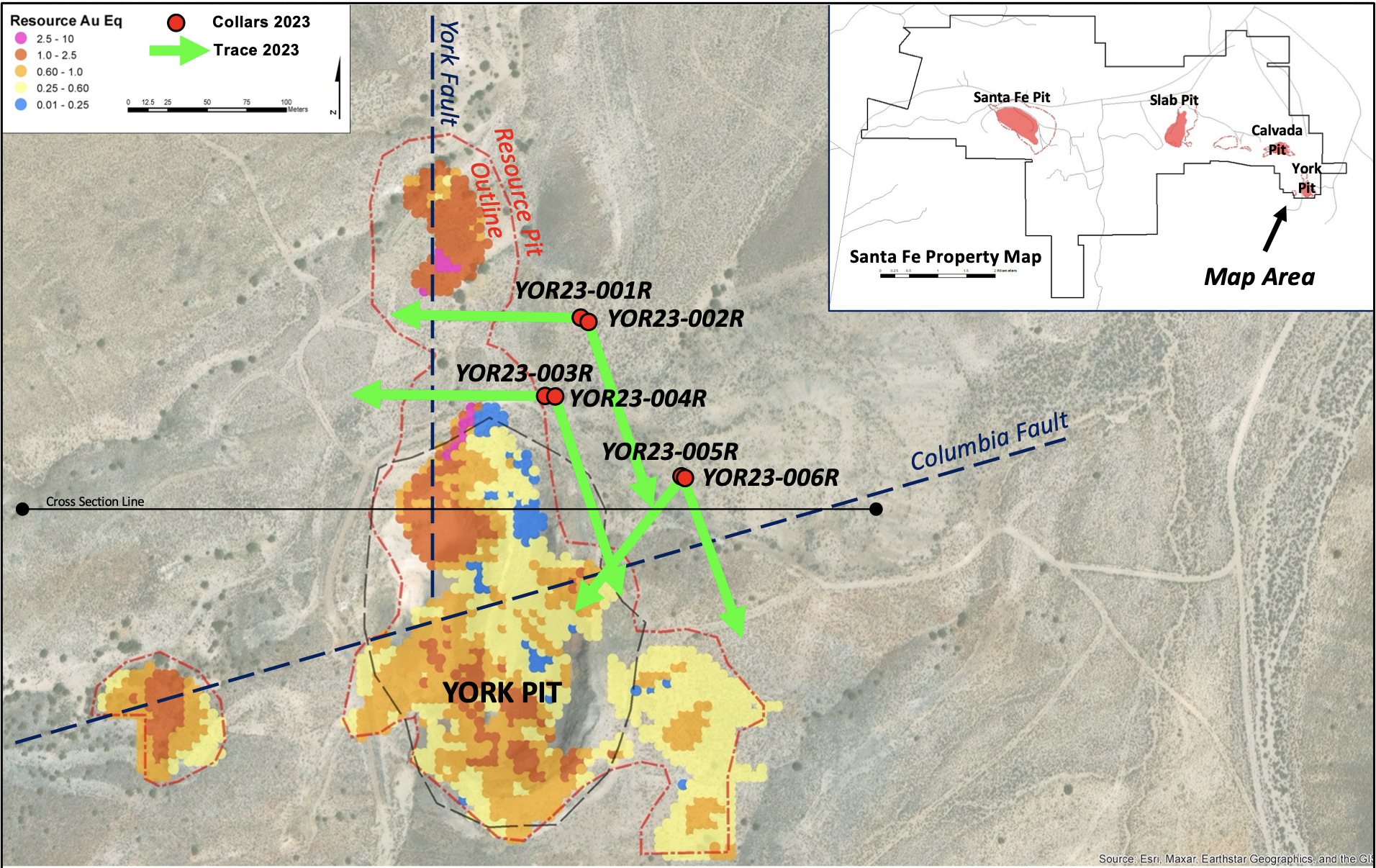
In the cross section (above), the York drill holes are east of the known resources targeting mineralization under historic drilling (please see plan view and cross section above), therefore the intercepts expand the area of known gold mineralization. Also, during the pit optimizing process, the new intercepts can potentially “pull-down” the conceptual pit shell to capture resource blocks outside the current conceptual shell, which should expand the pit constrained MRE.
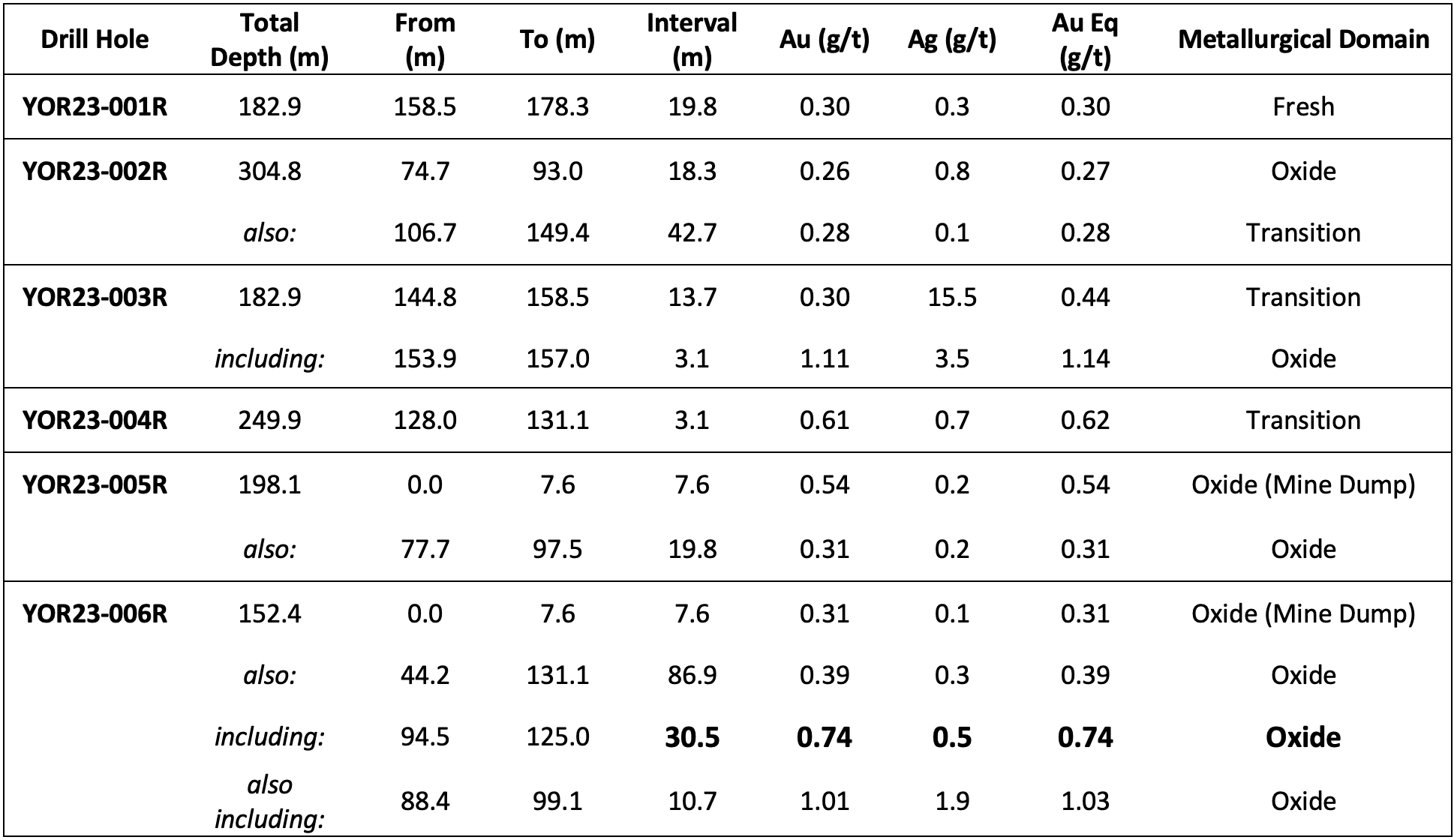
* Please see the Santa Fe Project Technical Report, Authors: Trevor Rabb and Darcy Baker, P. Geos. Effective Date: December 7, 2022, Report Date: March 2, 2023. The Technical Report is available on the Company’s website and SEDAR.
The final five drill holes of the 2024 drill program were completed in the Slab and Santa Fe pit areas at the Santa Fe Mine where previous outlined significant shallow oxide domain gold and silver resources that remained open along strike and down-dip. The 1,053 metres of drilling targeted potential extensions of gold and silver resources and the confirmation of pit boundaries for the updated Mineral Resource Estimate.
- • 48.8 metres grading 0.44 g/t Au 48.8 metres grading 0.44 g/t Au and 7.4 g/t Ag (0.51 g/t Au Eq) of shallow oxide mineralization in drill hole CAL24-007R including 7.6 metres grading 1.08 g/t Au and 8.3 g/t Ag (1.16 g/t Au Eq). This drill hole, and CAL24-009R reported below, intercepted significant widths of oxide gold and silver mineralization approximately 350 metres north of the Slab open pit and almost 100 metres north of the MRE conceptual pit shell, greatly expanding the footprint of gold and silver mineralization at the Slab open pit.
- • 7.6 metres grading 2.06 g/t Au and 18.2 g/t Ag (2.22 g/t Au Eq) in drill hole CAL24-009R including 3.1 metres grading 4.26 g/t Au and 18.2 g/t Ag (4.41 g/t Au Eq) within a 50.4 metre total thickness of gold and silver mineralized rock. This drill hole contains some of the highest gold and silver grades seen at the Slab deposit: 5.22 g/t Au (77.7 -79.2m) and 151 g/t Ag (112.8– 114.3m). This drill hole, coupled with CAL24-007R, open a large area for resource expansion north and northeast of the Slab Pit


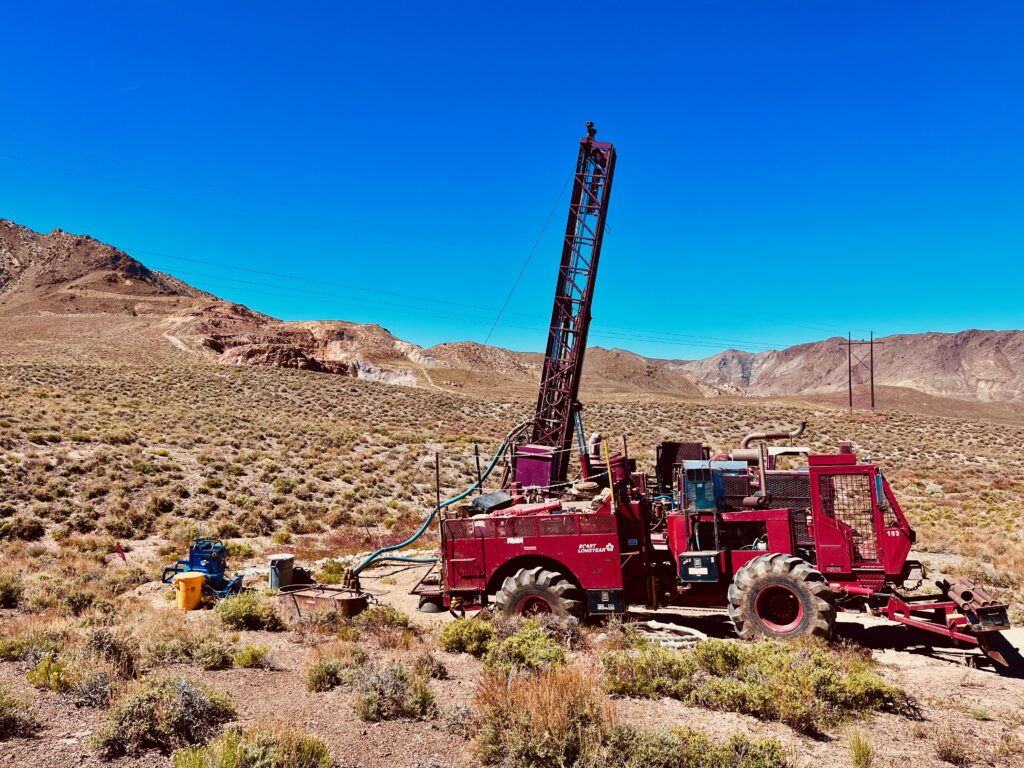
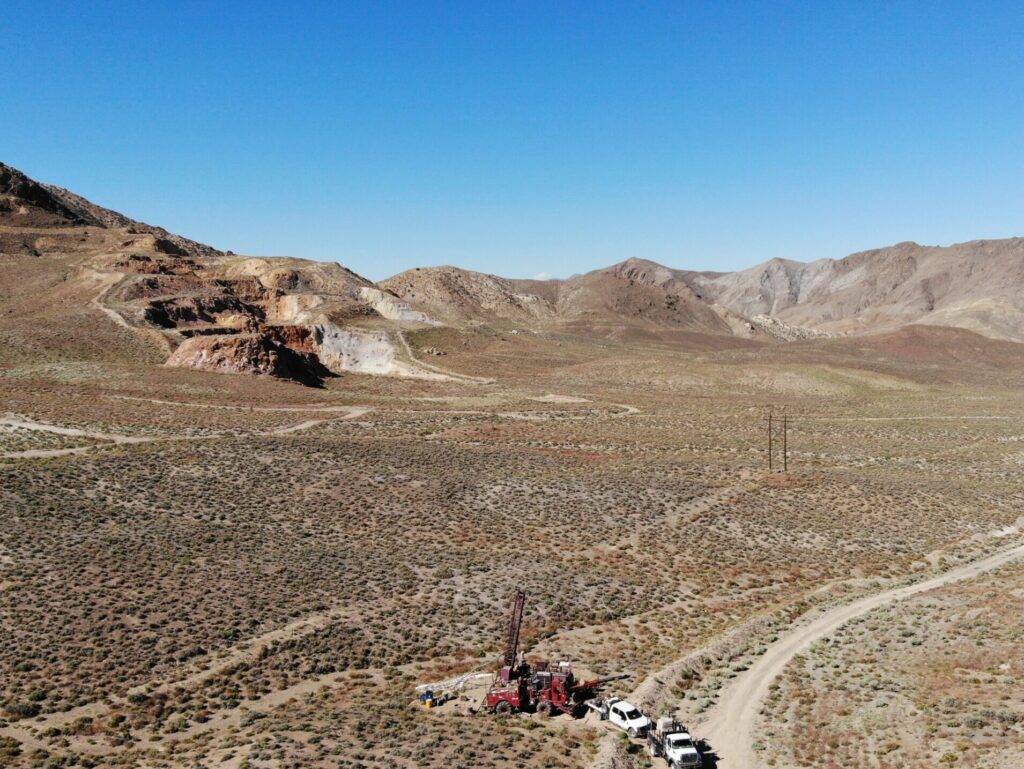
- Target Area
- Isabella Pearl

• The Pinnacle target area is host to a large (2,500 by 500m) zone of intense hydrothermally altered and gold mineralized Miocene volcanic rock.
• The system is defined by gold in-soil anomalies and rock chip samples grading up to 6.6 gpt Au associated with northwest trending structures.
• The target is on strike with the Isabella Pearl open pit gold mine operated by Fortitude Gold.
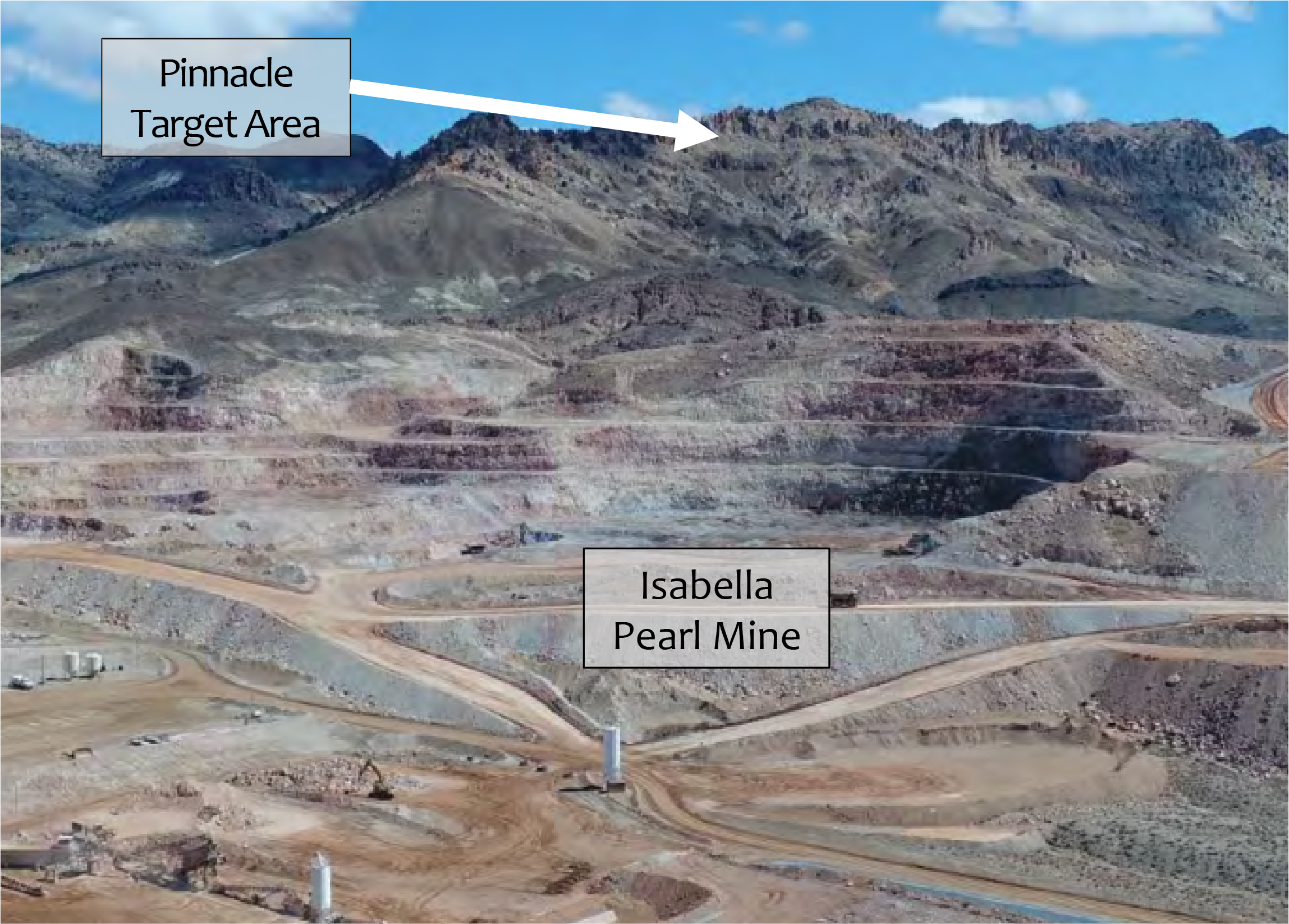
• The Isabella Pearl mine has P&P Reserves of 2.3M tonnes grading 3.05 gpt Au, 18 gpt Ag (220,100 oz Au, 1.2M oz Ag). The higher grade Pearl zone averages over 4 gpt Au.
• Fortitude Gold reported 2021 production over 45,000 ounces Au, and projects LOM cash costs of US$650/ oz Au, excellent heap leach recoveries (>81%).
• The Pinnacle target is contiguous with the Isabella Pearl and shares a nearly identical geologic setting and has not been drilled: an excellent opportunity to add resource ounces to the Santa Fe Project.

